Building the Beloved Character, part 1
/That the woman was Dutch seemed at first to be an obstacle, but then I realized it was in fact an unexpected but perfect solution.
Read MoreInternational Award-Winning Author
That the woman was Dutch seemed at first to be an obstacle, but then I realized it was in fact an unexpected but perfect solution.
Read MoreAlthough author Nancy Blanton may not be a household name yet, after reading her intriguing novel The Earl in Black Armor we think that may very well change in the near future.
Read MoreDivided by a gentle curve in the great River Boyne, the town of Drogheda in County Louth is one of the oldest and largest in Ireland.
Read MoreMalahide Castle is famous for surviving through tumultuous and violent centuries, and provides a fascinating glimpse into life in an ancient fortress, and the enduring spirit of the family that lived there.
Read MoreJust before the turn of the 17th century in 1593, Thomas Wentworth was born in London, into fortune, property and prestige. But he sought more than anything what he did not have: a royal title. An earldom. It would come at the greatest cost.
Read MoreTo walk along the road in front of several quaint thatched cottages, you might believe you are in an ancient neighborhood, and perhaps wish that you were.
Read MoreMallow Castle has large mullioned windows, loopholes for muskets, and fireplaces in each room that stir the imagination. Who once warmed their hands or dried their clothes there, and what did they think about?
Read MoreOn a dark June night of 1631, three ships arrived carrying Algerian pirates who stormed ashore, killing two of the town’s residents and capturing 107 men, women and children.
Read MorePart 8 in a series featuring sites I visited in Ireland while researching my second novel, The Prince of Glencurragh. See previous posts listed at the end. Sometimes, though sand and water wash away the past, research and imagination still can resurrect it.
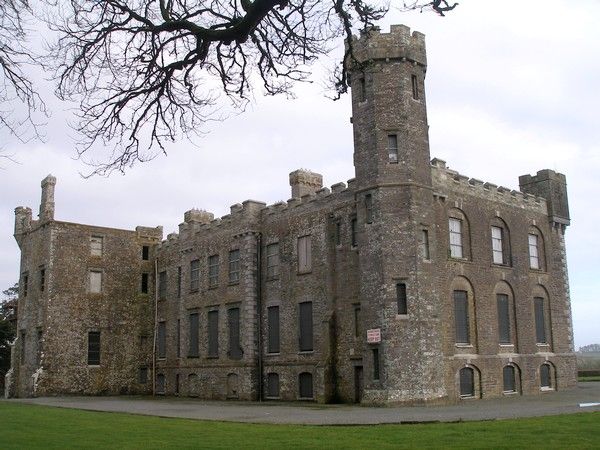
From Timoleague, Clonakilty is nearly a straight shot west along the R600. Heading south from there are rolling hills, green bluffs and marshy expanses leading toward Dunnycove Bay. On most driving and tour maps you’ll see a notation for Castlefreke.
Built by Randall Oge Barry in the 15th century, the fort was lost to the English after the Battle of Kinsale, was besieged and later burned during the Rebellion of 1641. A tower house was built on the site in 1780, which was remodeled in 1820, burned down in 1910, and at the time of my visit it was being remodeled as an event venue. However we did not visit Castlefreke itself, because it was not my destination. Instead, I wished to see Rathbarry Castle, the Red Strand, and just a little farther west, Coppinger’s Court.
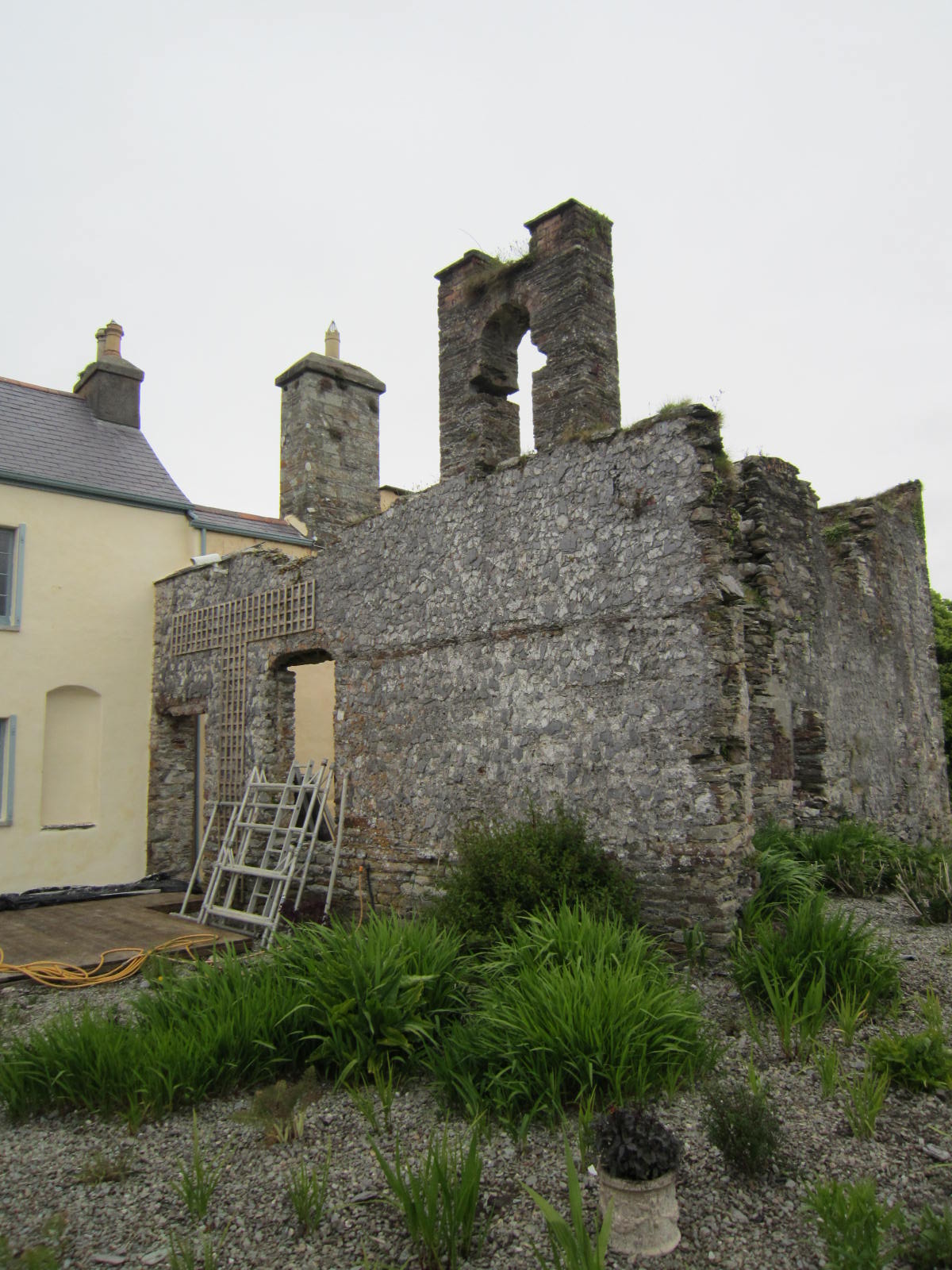
Featuring characters from the Barry family in The Prince of Glencurragh, I sought locations where they might have met or slept. I was to find little remaining of the castle, but enough to stir my imagination, and even more so, the illuminate larger forces that had been in play in the region.
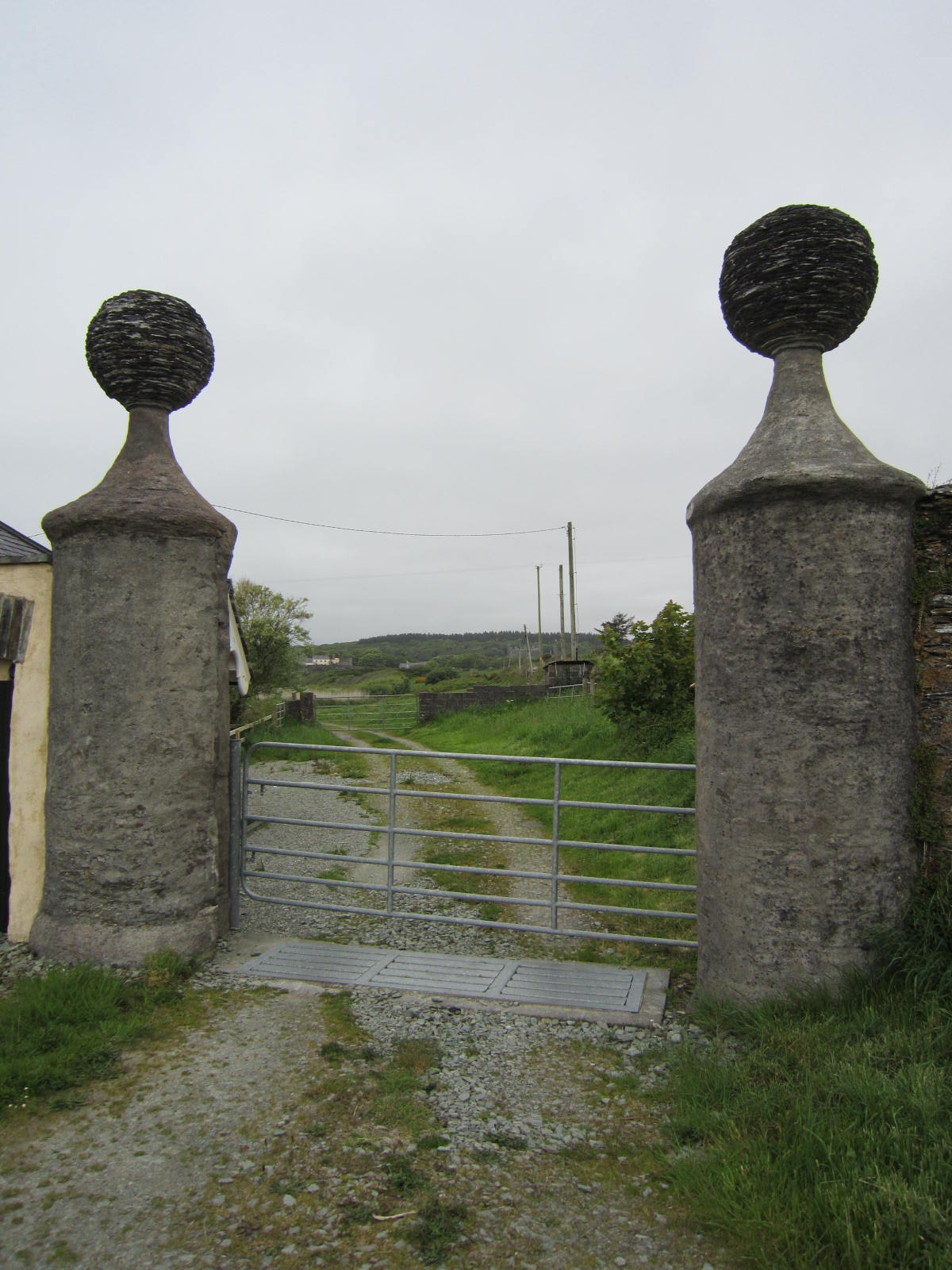
Thanks to my friends Eddie and Teresa, who introduced me to their friend Pat Hogan, I was able to visit and learn much about Rathbarry, and it became a landmark in the book, near the cottage of the mysterious healer Pol-Liam.
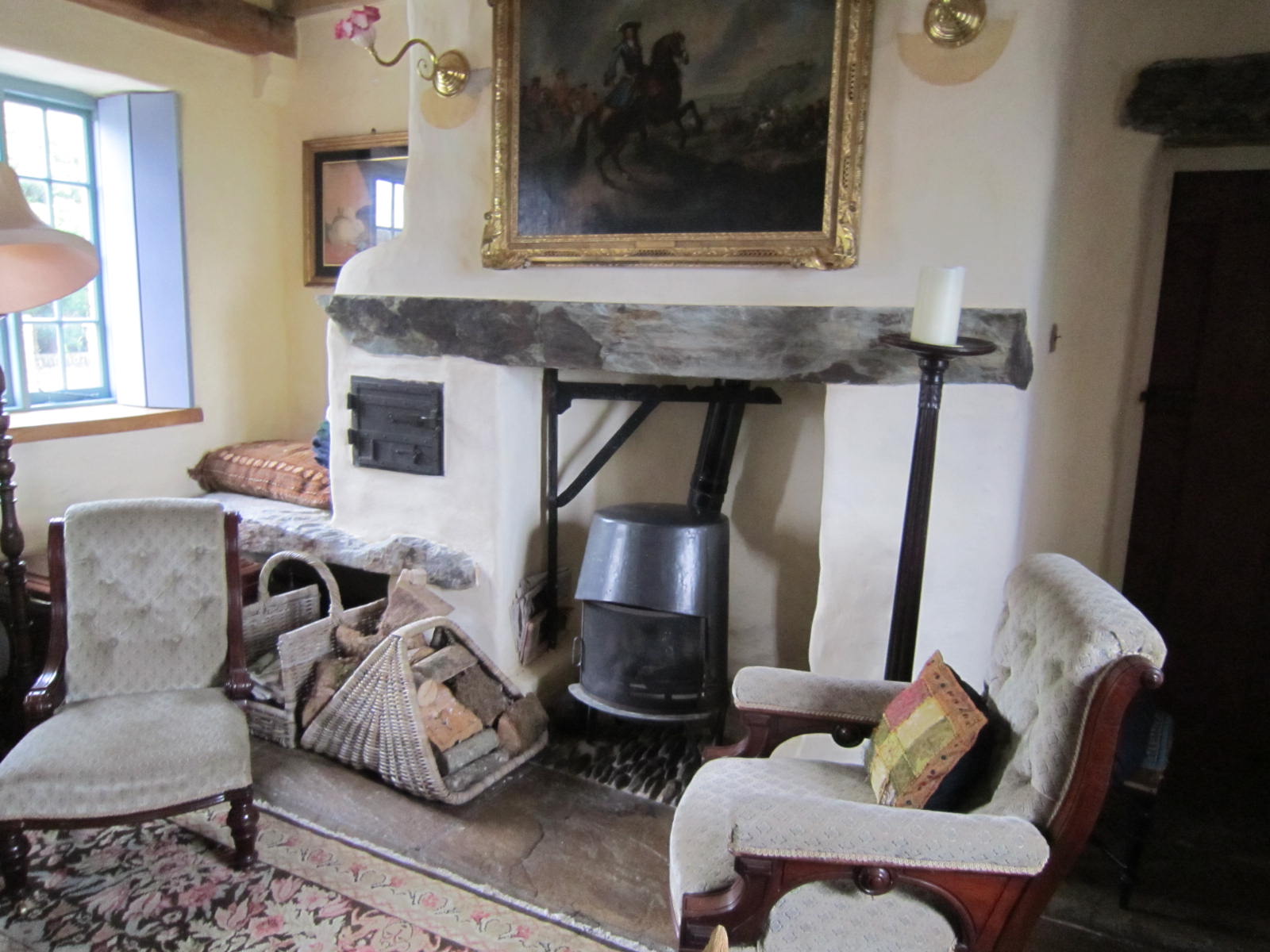 The castle Rathbarry existed on the site of what is now Castlefreke, bearing the family name of Freke for the current owners. Far out on the roadway, the gateposts marking the entrance to the castle grounds with their large spherical tops were said to be true remnants of the 17th century. Just one wall of the ancient stables and carriage house remained, and a new stable house had been built within it remodeled as a private residence. We were treated to a peek inside this structure to get a feel for what home life was like there.
The castle Rathbarry existed on the site of what is now Castlefreke, bearing the family name of Freke for the current owners. Far out on the roadway, the gateposts marking the entrance to the castle grounds with their large spherical tops were said to be true remnants of the 17th century. Just one wall of the ancient stables and carriage house remained, and a new stable house had been built within it remodeled as a private residence. We were treated to a peek inside this structure to get a feel for what home life was like there.
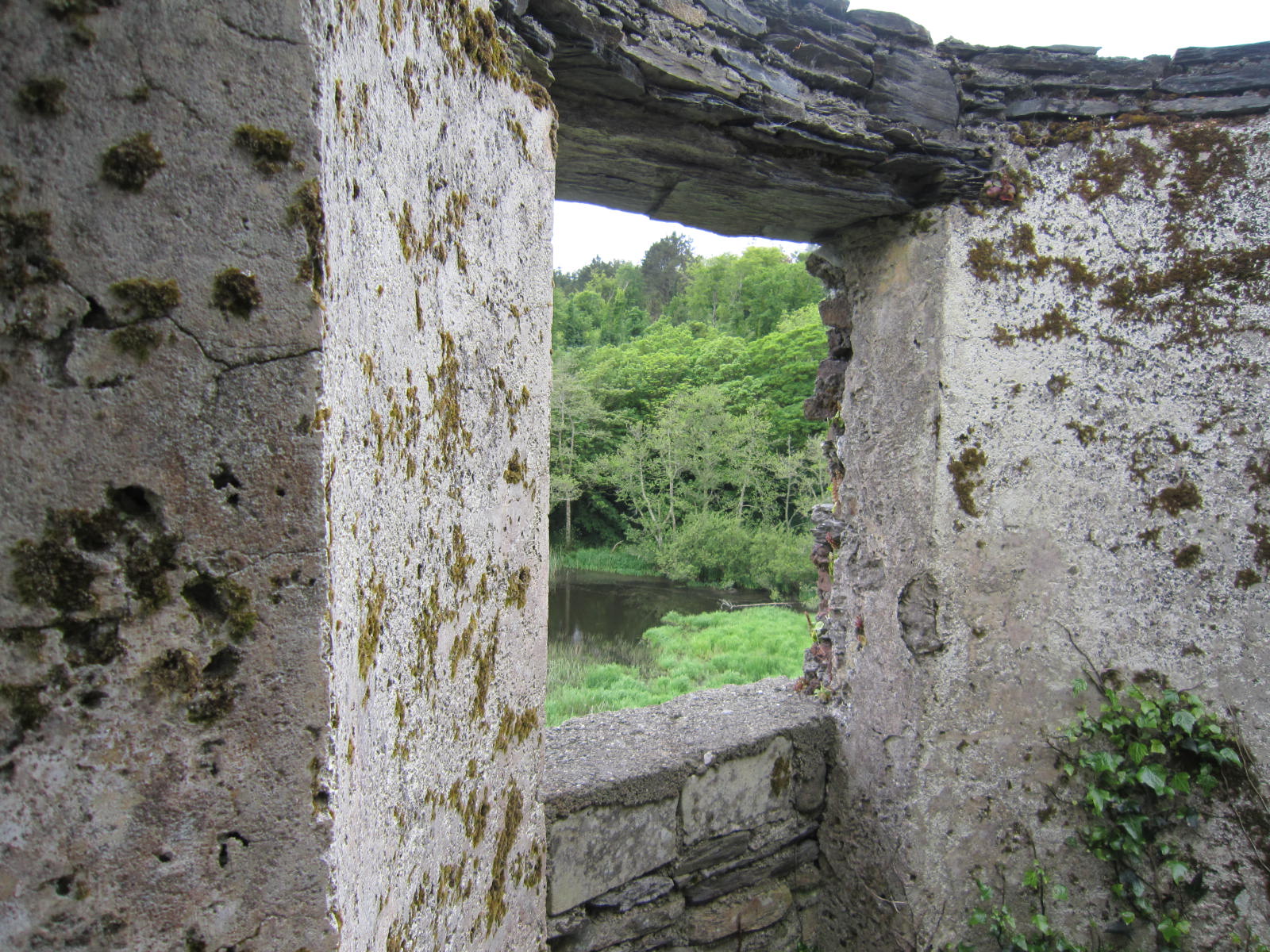 From the upper wall of the ruin, crumbling stone stairs led down to an ancient watergate, a stone passage leading directly from the castle to the water, where boats would have come to deliver food and supplies. But, except for a small, enclosed pond, there was no water. From the top of the steps I could see the bay, maybe half a mile distant. How, I wondered, could the castle have been served from such a distance?
From the upper wall of the ruin, crumbling stone stairs led down to an ancient watergate, a stone passage leading directly from the castle to the water, where boats would have come to deliver food and supplies. But, except for a small, enclosed pond, there was no water. From the top of the steps I could see the bay, maybe half a mile distant. How, I wondered, could the castle have been served from such a distance?
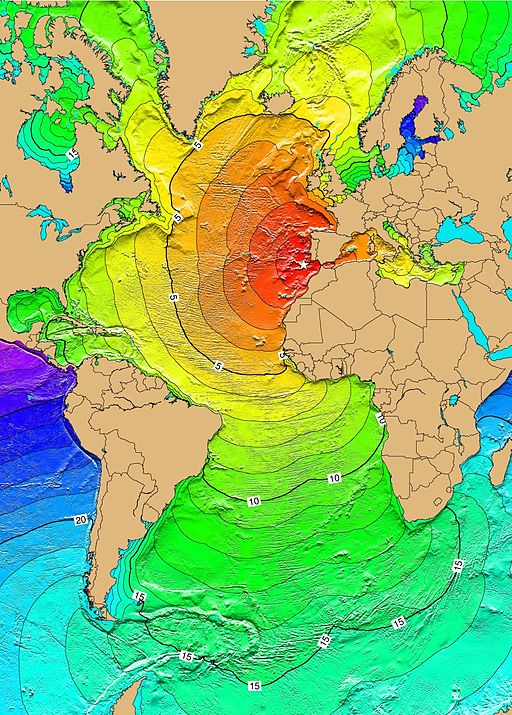
As Mr. Hogan reminded me, the landscape had changed dramatically since the 17th century, and events at the global level could have affected Ireland’s coastlines. In fact, in 1755 the Great Lisbon Earthquake and tsunami are believed to have done so. Considered one of the deadliest earthquakes in history, it is estimated to have hit the 8.5 to 9.0 range on today’s scale of magnitude, killed thousands of people and nearly devastated Lisbon. The tsunami’s impact was far-reaching.
“Tsunamis as tall as 20 metres (66 ft) swept the coast of North Africa, and struck Martinique and Barbados across the Atlantic. A three-metre (ten-foot) tsunami hit Cornwall on the southern English coast. Galway, on the west coast of Ireland, was also hit, resulting in partial destruction of the "Spanish Arch" section of the city wall. At Kinsale, several vessels were whirled round in the harbor, and water poured into the marketplace.” ~ Charles Lyell, Principles of Geology, 1830
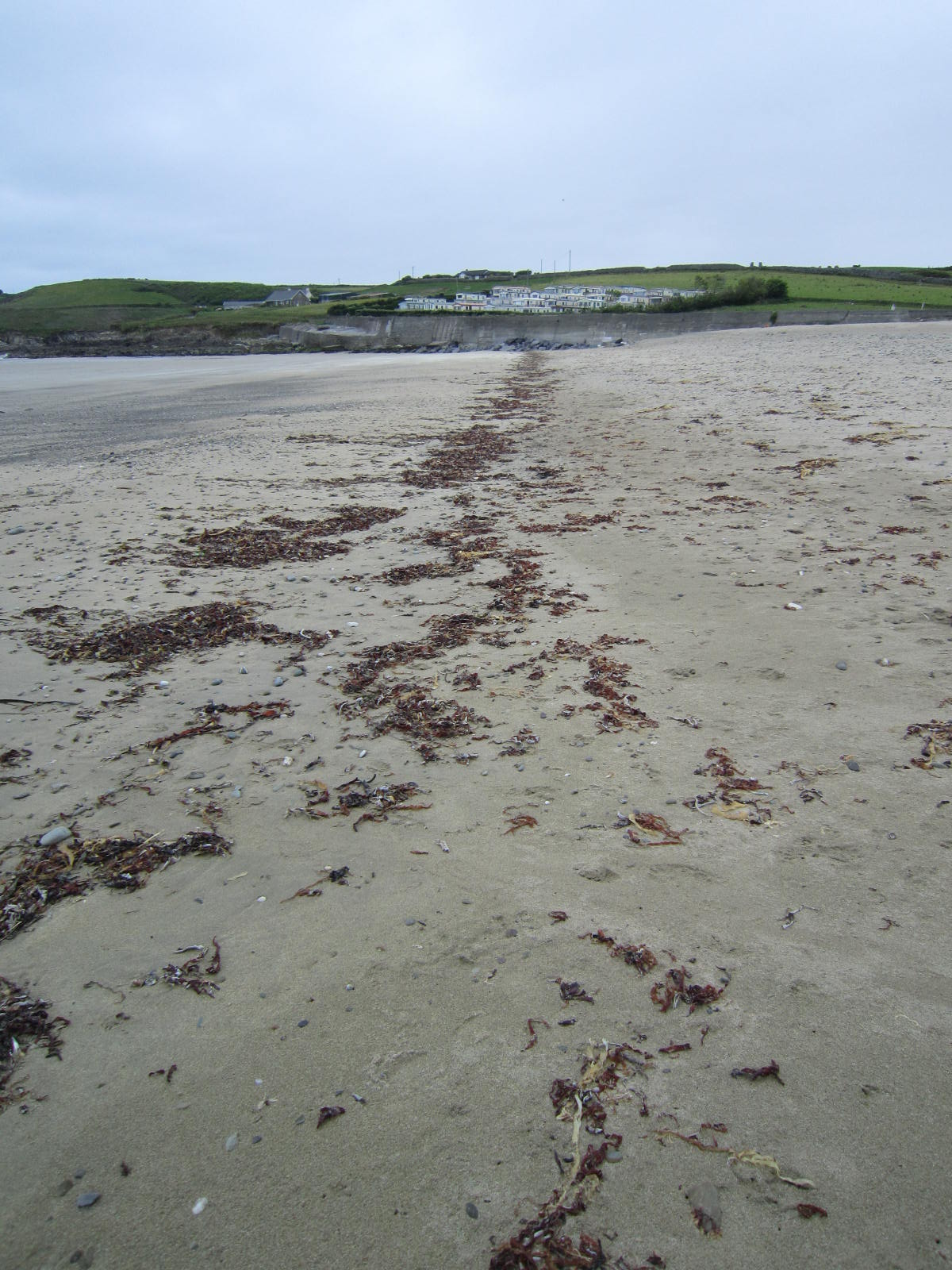 Gigantic waves were reported as well in the West Indies and Brazil. Could these environmental events have shifted sands and reshaped Ireland’s coastline? Undoubtedly.
Gigantic waves were reported as well in the West Indies and Brazil. Could these environmental events have shifted sands and reshaped Ireland’s coastline? Undoubtedly.
Almost within view of Rathbarry was another site I wished to visit: the Red Strand. Also likely to have been altered by the tsunami, this sandy beach was called “red” because the sand contained fossilized sea creatures or “calcareous matter,” which was believed to have a healing effect and also promote fertility. As late as the 19th century the sand was being collected for use in fertilizing crops some 16 miles away.
The only red I saw during my visit was in the clumps of seaweed washed ashore; still, the strand fascinates, bounded on one side by stones, and on the other by bluffs and stream. The strand and the story behind it served my imagination for a deadly scene in the book.
Next time: Coppinger’s Court.
Part 1 - Kanturk Castle
Part 2 - Rock of Cashel
Part 3 - Barryscourt
Part 4 - Ormonde Castle
Part 5 - Lismore Castle
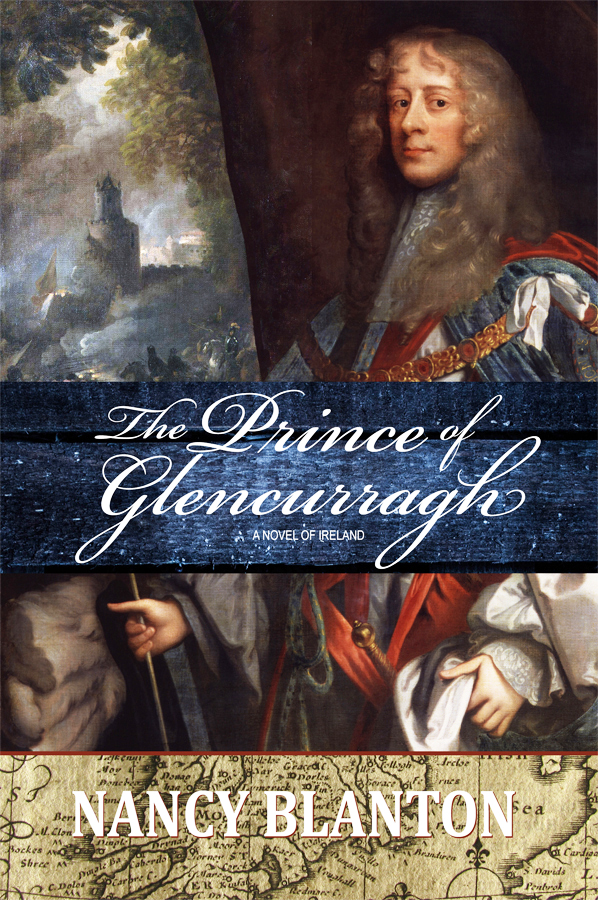 An heiress, a castle, a fortune: what could go wrong?
An heiress, a castle, a fortune: what could go wrong?
The Prince of Glencurragh is available in ebook, soft cover and hard cover from online booksellers.
https://books2read.com/u/4N1Rj6
http://www.amazon.com/Prince-Glencurragh-Novel-Ireland-ebook/dp/B01GQPYQDY/
Part 7 in a series featuring sites I visited in Ireland while researching my second novel, The Prince of Glencurragh. See previous post links below.
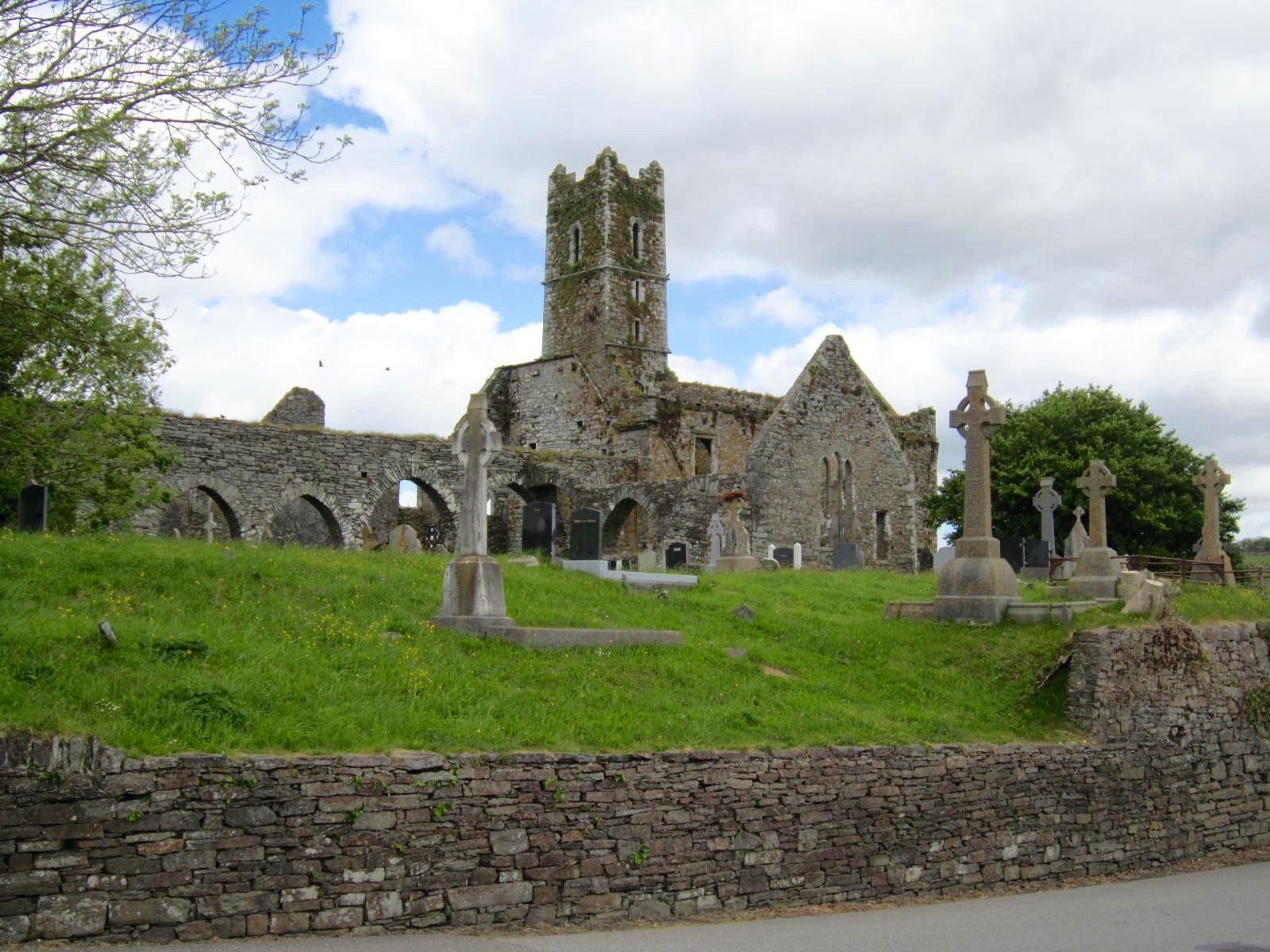 Driving south from Bandon on R602, you will arrive at the town of Timoleague in about 20 minutes, and see immediately the great landmark of Timoleague Friary. For the Prince of Glencurragh, traveling on horseback, at night and over rugged terrain, it would have taken at least three hours to reach this first stop on Faolán Burke’s path to destiny.
Driving south from Bandon on R602, you will arrive at the town of Timoleague in about 20 minutes, and see immediately the great landmark of Timoleague Friary. For the Prince of Glencurragh, traveling on horseback, at night and over rugged terrain, it would have taken at least three hours to reach this first stop on Faolán Burke’s path to destiny.
In the 17th century, local parishes were required to maintain their roads, especially in market towns. In 1634, a new act of Parliament allowed for a tax levy to cover the costs. But it would be decades before Ireland’s road systems were noted for improvements. A Scotsman traveling through Ireland in winter around 1619-1620 described his horse as “sinking to his girth” on boggy roads, his saddles and saddlebags destroyed.
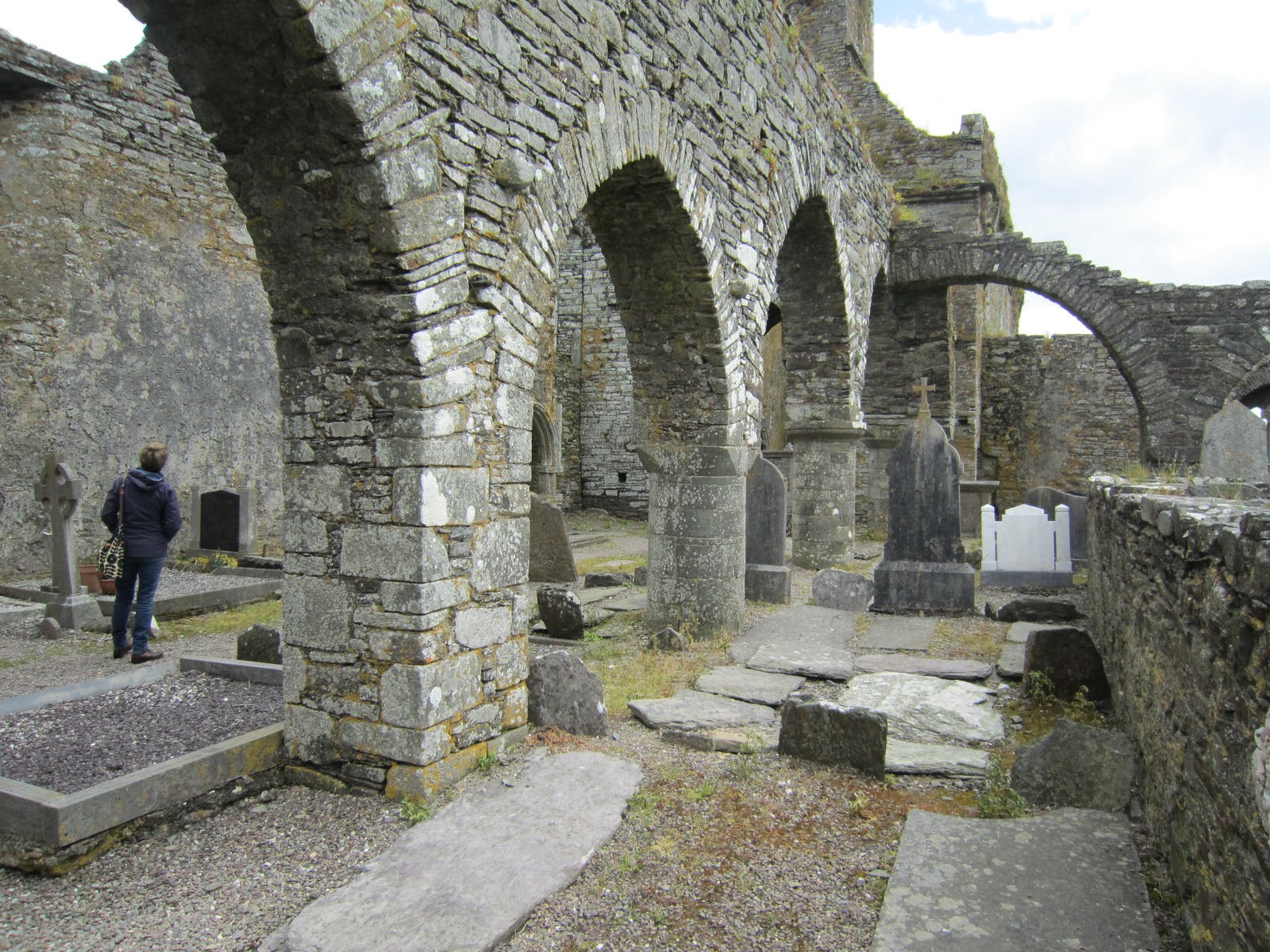 Timoleague Franciscan friary would have provided a most welcome shelter to travelers, even it its ruined state. It remains a massive and impressive structure, the walls of the various rooms still intact so that you can recognize the floor plan and how each room was used. The roof is long gone, and some sources say that parts of the structure were carted away for use in other buildings.
Timoleague Franciscan friary would have provided a most welcome shelter to travelers, even it its ruined state. It remains a massive and impressive structure, the walls of the various rooms still intact so that you can recognize the floor plan and how each room was used. The roof is long gone, and some sources say that parts of the structure were carted away for use in other buildings.
 From the mullioned window in the chorus, one would be hard-pressed to find a view more peaceful and contemplative. This is the spot where my heroine, Vivienne, considers her circumstances, having been abducted by three strange men, however benevolent they might have seemed. It’s the place where narrator Aengus recalls a treasured time with his father. And it is where he and Vivienne first realize a common bond.
From the mullioned window in the chorus, one would be hard-pressed to find a view more peaceful and contemplative. This is the spot where my heroine, Vivienne, considers her circumstances, having been abducted by three strange men, however benevolent they might have seemed. It’s the place where narrator Aengus recalls a treasured time with his father. And it is where he and Vivienne first realize a common bond.
Scenes in the book came alive for me as I entered each room and walked the same paths of monks and soldiers, and imagined conversations echoed in my mind.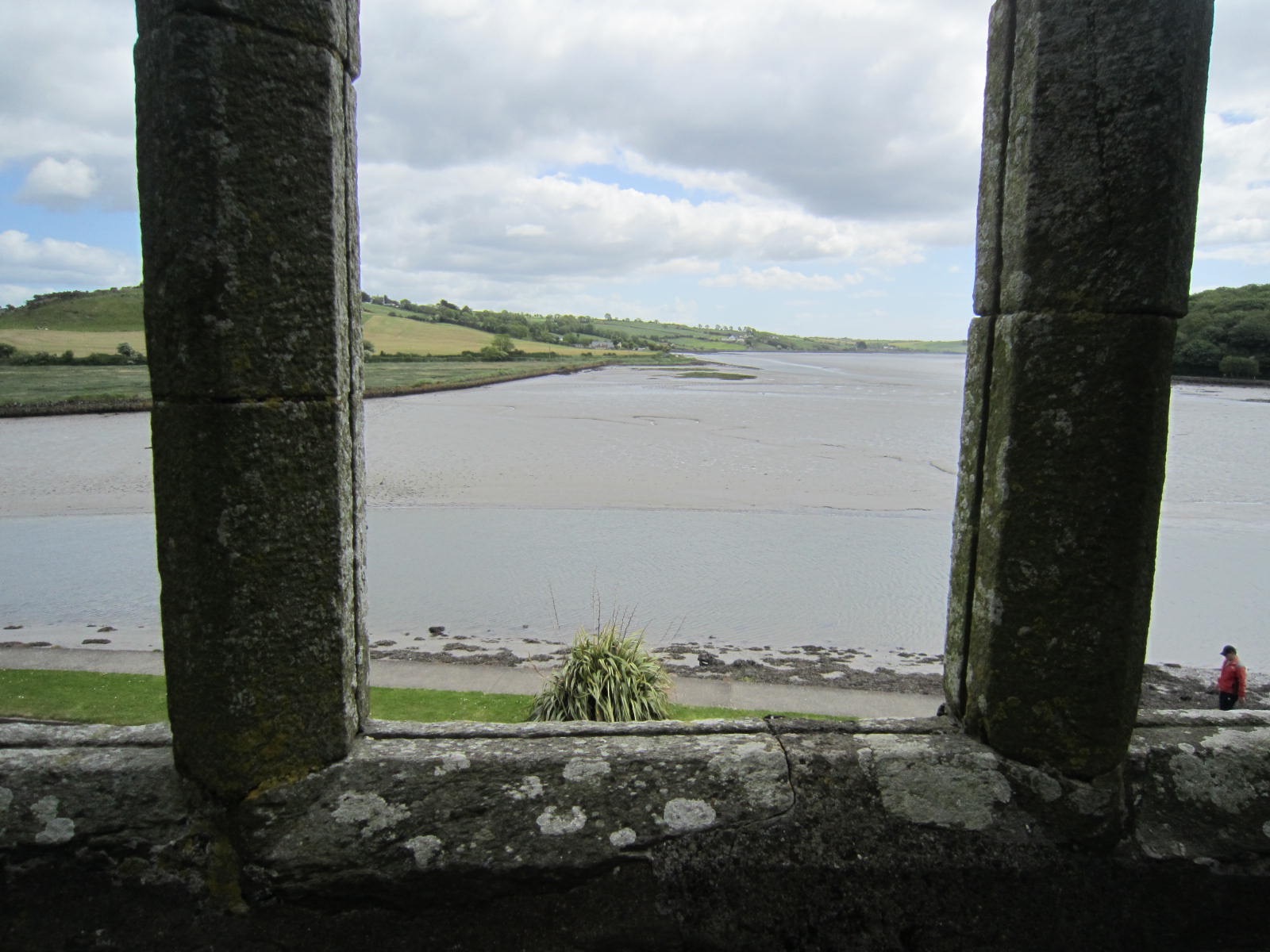
Timoleague is an Anglicization of the Irish Tigh Molaige, meaning House of Malaga for St. Malaga who is believed to have first brought beekeeping to Ireland. Foundation of the friary is attributed to the McCarthys in the 13th century, and also to William de Barry and his wife Margery de Courcy in the 14th century. Unfortunately, its position along the beautiful River Argideen and overlooking Courtmacsherry Bay made it vulnerable to Algerian pirates who sometimes cruised Ireland’s coastline in search of hostages and plunder.
 However, pirates may have seemed a minor threat compared the friary’s fate in the hands of the English. In King Henry VIII’s time, the structure was seized and as part of the Reformation the monks were dispersed. The monks returned in 1604, and then the English soldiers returned in 1612 to sack the buildings and smash all the stained glass windows. Then in 1642, English soldiers fighting the great Irish rebellion burned both the friary and town.
However, pirates may have seemed a minor threat compared the friary’s fate in the hands of the English. In King Henry VIII’s time, the structure was seized and as part of the Reformation the monks were dispersed. The monks returned in 1604, and then the English soldiers returned in 1612 to sack the buildings and smash all the stained glass windows. Then in 1642, English soldiers fighting the great Irish rebellion burned both the friary and town.
Many headstones dot the friary’s hillside, and large stone tombs in the nave are so ancient the chiseled inscriptions are no longer legible. Yet, the ruin is still an active cemetery for the local community.
Series posts:
Part 1 – Kanturk Castle Part 2 – Rock of Cashel
Part 3 – Barryscourt Part 4 – Ormonde Castle
Part 5 – Lismore Castle Part 6 - Bandon, Kilcolmen
 An heiress, a castle, a fortune: what could go wrong?
An heiress, a castle, a fortune: what could go wrong?
The Prince of Glencurragh is available in ebook, soft cover and hard cover from online booksellers.
https://books2read.com/u/4N1Rj6
http://www.amazon.com/Prince-Glencurragh-Novel-Ireland-ebook/dp/B01GQPYQDY/
See all of my books and other information at
Part 6 in a series featuring sites I visited in Ireland while researching my second novel, The Prince of Glencurragh. See previous posts listed at the end.
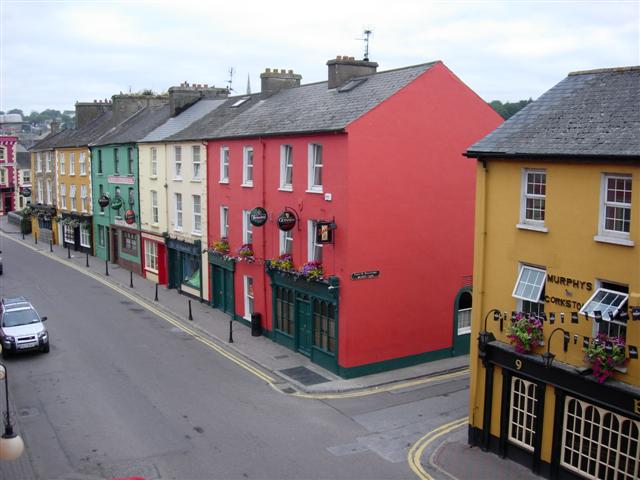
My research for The Prince of Glencurragh truly gained momentum when I visited Bandon in County Cork. Here I saw the place where my story began, and realized my reconnection with an old friend was the key that would allow the story to unfold.
Known as the gateway to West Cork, the city of Bandon lies 27 km (not quite 17 miles) west of Cork City. Established in 1604 as part of King James I’s Munster Plantation, it was a planned settlement English Protestants in Ireland. The famous stone bridge dates back at least to 1594, connecting people on either side of the Bandon River to facilitate trade. A timber bridge had existed even earlier, built by the O’Mahony (Oh-MAY-hon-ee) clan in 14th century.
When Richard Boyle, the first Earl of Cork, acquired the lease for all the properties of the town, he began a five-year project to enclose 27 acres within a wall nine feet thick and from 30 to 50 feet high in some places. On the heels of the Desmond Rebellions, this was intended to protect the peaceful settlers within against the wild Irish without.
Protection was needed against the unrest the settlement itself had created. Bandon lands had belonged to the O’Mahony and McCarthy clans, and the displacement left Irish families homeless and their sons without inheritance, sowing seeds for an even greater rebellion than the Desmonds could muster.
For the story in The Prince of Glencurragh, Bandon’s wall is critical, because certain local laws were enforced by a sheriff within the town’s walls, but did not extend beyond them. When the would-be “prince” Faolán Burke abducts his heiress from a rectory situated outside the town walls, technically he has broken no laws.
In preparation for my travels, my research uncovered a near-perfect model for this rectory, the Kilcolmen Rectory just east of where the walls of Bandon would have reached. To my surprise and delight, my dear friends and guides Eddie and Teresa actually live in Bandon (I had thought they still lived in Templemore).
I met Eddie when I was 19 or 20, visiting Ireland for a summer study program, and had the privilege of staying with his family in Skibbereen for a few days. We had not seen each other in decades, and so the reconnecting was gratifying and emotional.
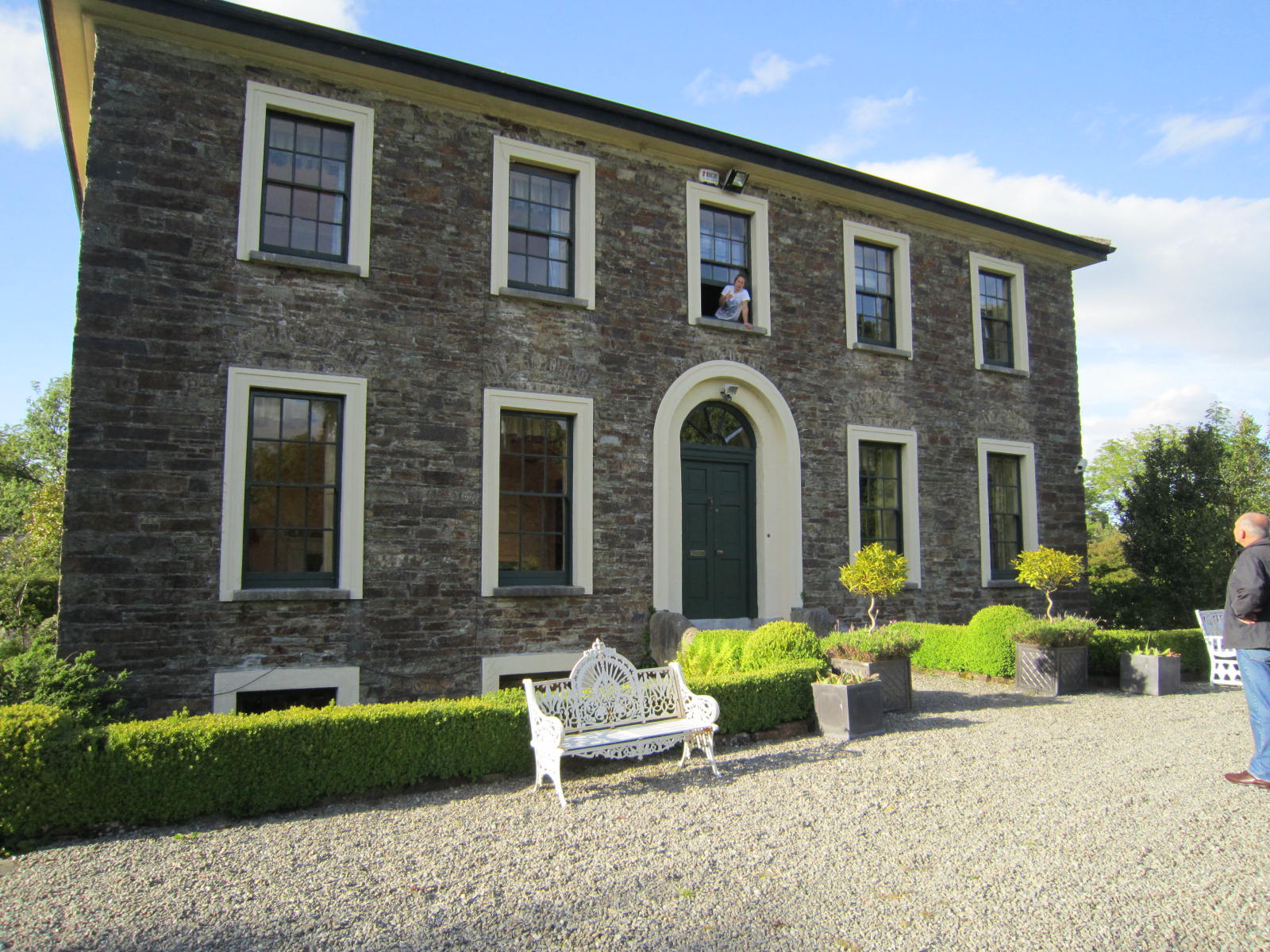 Eddie knew of the rectory and was able to take me straight there. Though it is now a private home, Eddie chatted with the resident—she was leaning out of the upstairs bathroom window where she’d been bathing her children—while I looked about the house and grounds. We did not go inside, but Eddie sent me some interior photos he happened upon when the house went on the real estate market months later.
Eddie knew of the rectory and was able to take me straight there. Though it is now a private home, Eddie chatted with the resident—she was leaning out of the upstairs bathroom window where she’d been bathing her children—while I looked about the house and grounds. We did not go inside, but Eddie sent me some interior photos he happened upon when the house went on the real estate market months later.
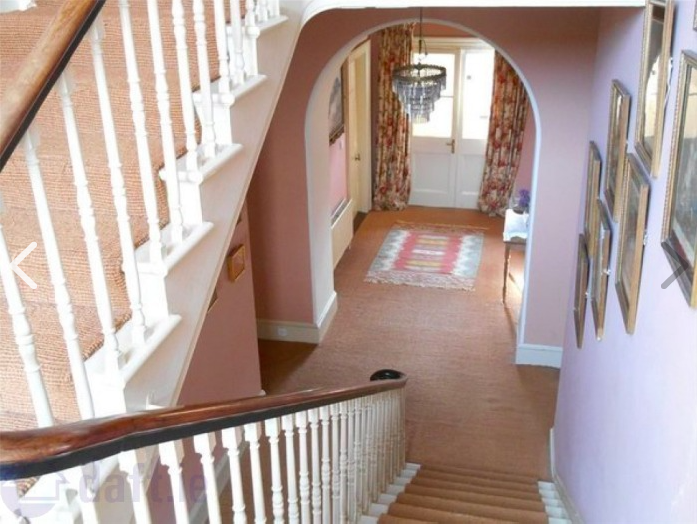 This rectory is much larger and finer than the one I had imagined, but served quite well to give me an authentic feel for the place. The front door is opposite the stairs, and on either side are doorways to the parlor and the dining room. I loved the enormous windows of the place, and the high ceilings. The bedroom is where the character Vivienne would have pushed her bed beneath a window to wait for St. Agnes to reveal the image of the man she would marry. The road outside would have been a dirt carriage path instead of a nice, clean paved drive.
This rectory is much larger and finer than the one I had imagined, but served quite well to give me an authentic feel for the place. The front door is opposite the stairs, and on either side are doorways to the parlor and the dining room. I loved the enormous windows of the place, and the high ceilings. The bedroom is where the character Vivienne would have pushed her bed beneath a window to wait for St. Agnes to reveal the image of the man she would marry. The road outside would have been a dirt carriage path instead of a nice, clean paved drive.
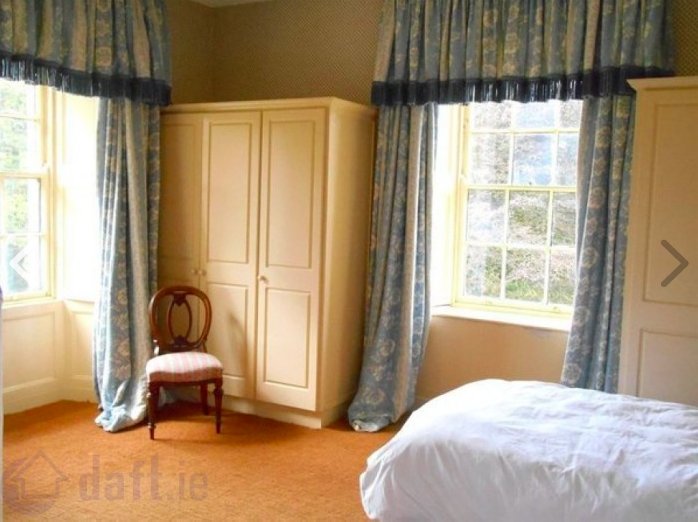 Eddie later showed me that Bandon’s town walls are mostly invisible now but for some crumbling remnants. Still, the wall sets the town apart and Bandon is a member of the Irish Walled Towns Network.
Eddie later showed me that Bandon’s town walls are mostly invisible now but for some crumbling remnants. Still, the wall sets the town apart and Bandon is a member of the Irish Walled Towns Network.
Upon seeing these things, the story became real to me and I could tell it with sincerity. But the truth is I would never have found or seen the places I was looking for without Eddie and Teresa. It is one thing to look at a map and draw circles and lines, and yet another to actually find your way around a mostly unmarked and unfamiliar region. They took me everywhere I wanted to go, for they knew each place already, and even more than that, they had personal history with some of them, a love of exploration, and an often unspoken but clear reverence for the land and its history.
They showed me a ruin not on my list, but beautiful and fascinating: Castle Bernard. Where once there had been a medieval castle belonging to the O’Mahonys, in 1788 the first earl of Bandon, Francis Bernard, built a beautiful mansion with tall windows and soaring castellated towers.
By the time it was inhabited by the 4th earl, James Francis Bernard, a new and modern rising came from the IRA. In June 1921, while the earl hid in the cellar, IRA soldiers set fire to the castle and captured the earl as he tried to escape. Now mostly swallowed up by the woods and vines, the magnificence and inaccessibility of the ruin spur the imagination.
From Bandon we would travel for three spectacular days to uncover the rest of Faolán Burke’s trail.
As a side note, my friends in the Pacific Northwest might like to know that Bandon has a twin city agreement with Bandon, Oregon. In 1873, Lord George Bennet founded the city and named it after his hometown in Ireland. Bennet is known for introducing the lovely-flowering but highly troublesome gorse to the American landscape.
Thanks to: Irish Walled Town Network, Heritage Bridges of County Cork (Cork County Council), Castles.nl, Wikipedia and other sources.
Part 1 - Kanturk Castle
Part 2 - Rock of Cashel
Part 3 - Barryscourt
Part 4 - Ormonde Castle
Part 5 - Lismore Castle
 An heiress, a castle, a fortune: what could go wrong?
An heiress, a castle, a fortune: what could go wrong?The Prince of Glencurragh is available in ebook, soft cover and hard cover from online booksellers.
https://books2read.com/u/4N1Rj6
http://www.amazon.com/Prince-Glencurragh-Novel-Ireland-ebook/dp/B01GQPYQDY/
Part 5 in a series featuring sites I visited in Ireland while researching my second novel, The Prince of Glencurragh. See previous post links below.
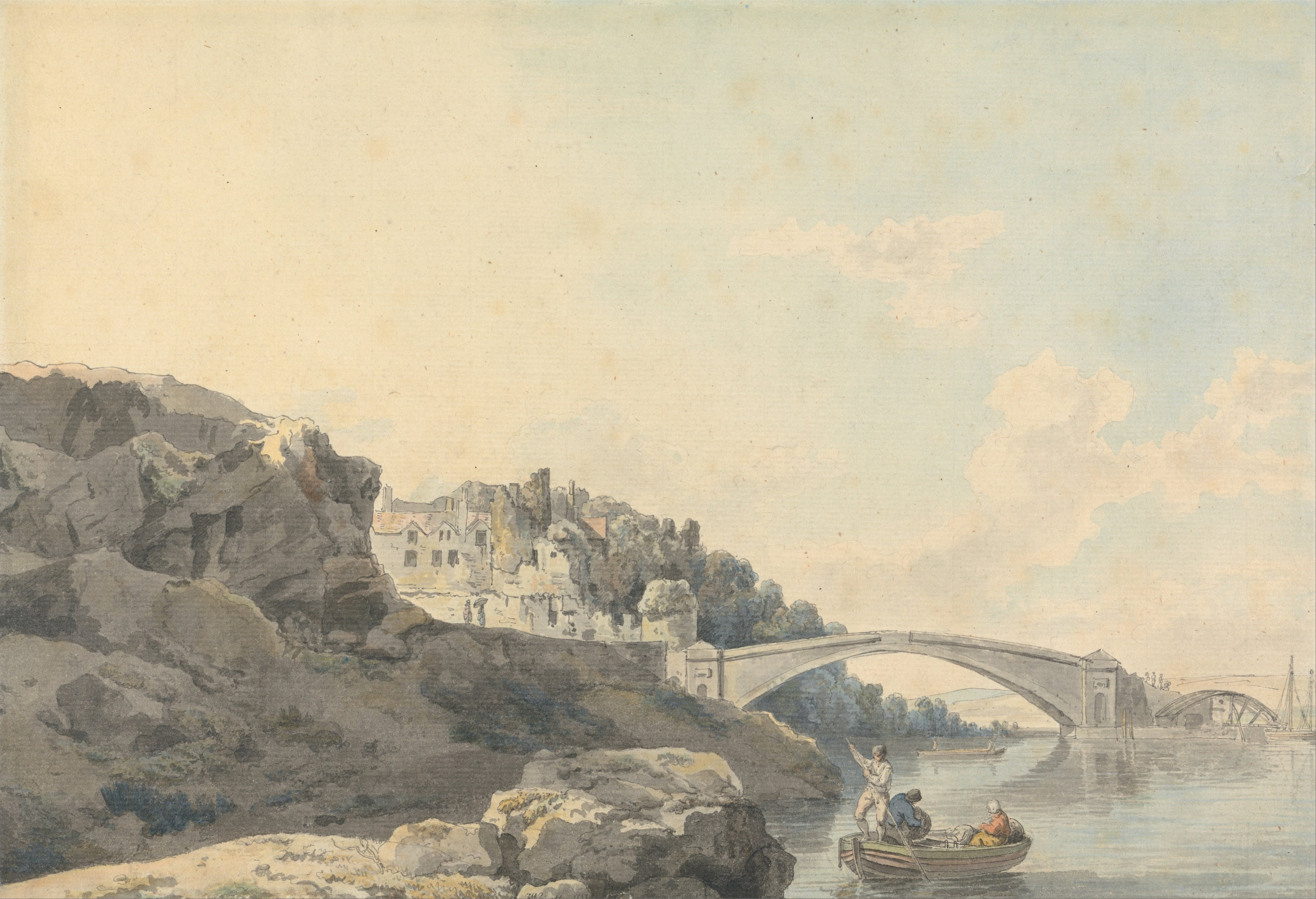
In The Prince of Glencurragh, the spectacular Lismore Castle in County Waterford is the setting for three emotionally-charged scenes. The grand drawing room and the ancient towers provide dramatic backdrops that help fortify the story.
Taking its name from “lis” meaning fort and “mor” meaning great, the castle is situated on the right bank of the River Blackwater in County Waterford. One story has it that when King James II visited the castle, he backed away from the grand window overlooking the river, startled by the sheer drop to the riverbank when the entrance to the castle is on 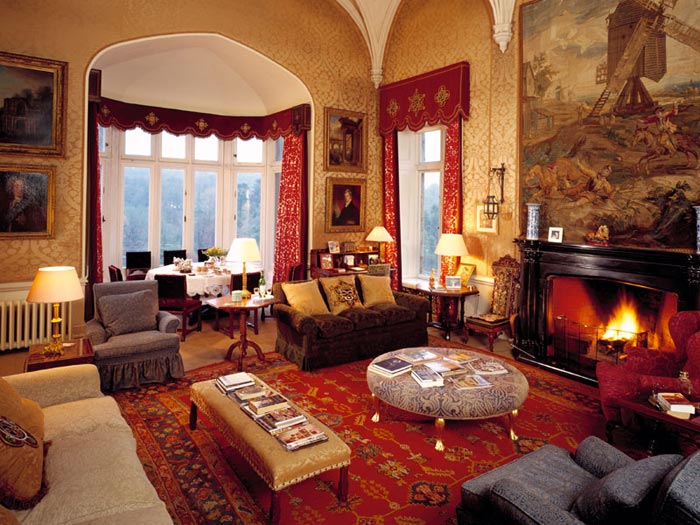 ground level. The window was ever-after called King James’s window.
ground level. The window was ever-after called King James’s window.
Sources differ as to the date of construction, but sometime between 1179 and 1185, Lismore was built on the site of the ancient abbey of Mochuda.
“This fine castle was originally founded by the Earl of Moreton, afterwards King John, in the year 1185, and is said to have been the last of three fortresses of the kind which he erected during his visit to Ireland. In four years afterwards it was taken by surprise and broken down by the Irish, who regarded with jealousy and fear the strong holds erected by the English to secure and enlarge their conquests.” -- LibraryIreland.com, the Dublin Penny Journal, Volume 1, Number 43, April 20, 1833
The castle was later rebuilt as an Episcopal residence (one source says it belonged to the earls of Desmond), until in 1589 when the manor and lands were granted to Sir Walter Raleigh. Sir Walter fell from grace after the death of Queen Elizabeth, and sold the estate to Sir Richard Boyle, the first Earl of Cork. Raleigh was later executed by King James to appease the Spanish, who saw Raleigh as a plundering pirate.

Lord Cork made extensive improvements to the castle for use as his primary residence. Outbuildings were added, and interiors embellished with fretwork plaster ceilings, tapestry hangings, embroidered silks and velvet.
“The first door-way is called the riding-house, from its being originally built to accommodate two horsemen, who mounted guard, and for whose reception there were two spaces which are still visible under the archway. The riding-house is the entrance into a long avenue shaded by magnificent trees, and flanked with high stone walls; this leads to another doorway, the keep or grand entrance into the square of the castle. Over the gate are the arms of the first Earl of Cork, with the motto, "God's providence is our inheritance.” -- LibraryIreland.com, the Dublin Penny Journal
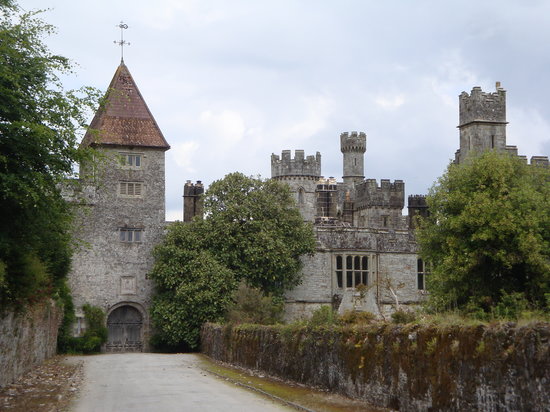 Some of the outbuildings were destroyed in the rebellion of 1641 when the castle was closely besieged by 5,000 Irish, and defended by Lord Broghill, the earl’s third son.
Some of the outbuildings were destroyed in the rebellion of 1641 when the castle was closely besieged by 5,000 Irish, and defended by Lord Broghill, the earl’s third son.
The Cavendish family acquired the castle in 1753 when the daughter and heiress of the 4th Earl of Cork, Lady Charlotte Boyle, married William Cavendish, 4th Duke of Devonshire, who became Prime Minister of Great Britain & Ireland. The 9th Duke, Lord Charles Cavendish, married Adele Astaire, the sister and former dancing partner of Fred Astaire.
Lismore is now an exclusive accommodation and event venue, and even offers culinary packages. The famous gardens are open to the pubic. The upper garden is a 17th-century walled garden, also briefly featured in my book.
Read other posts in the series: Part 1, Part 2, Part 3, Part 4.
 An heiress, a castle, a fortune: what could go wrong?
An heiress, a castle, a fortune: what could go wrong?
The Prince of Glencurragh has won the Royal Palm Literary Award for historical fiction. It is a story of 17th century Ireland, in a time of sweeping change prior to the great rebellion of 1641. Available in ebook, soft cover and hard cover from online booksellers.
https://books2read.com/u/4N1Rj6
http://www.amazon.com/Prince-Glencurragh-Novel-Ireland-ebook/dp/B01GQPYQDY/
See all of my books and sign up for my newsletter (published only 3 or 4 times a year) at nancyblanton.com
Part 4 in a series featuring sites I visited in Ireland while researching my second novel, The Prince of Glencurragh. See Part 1, Part 2 and Part 3.
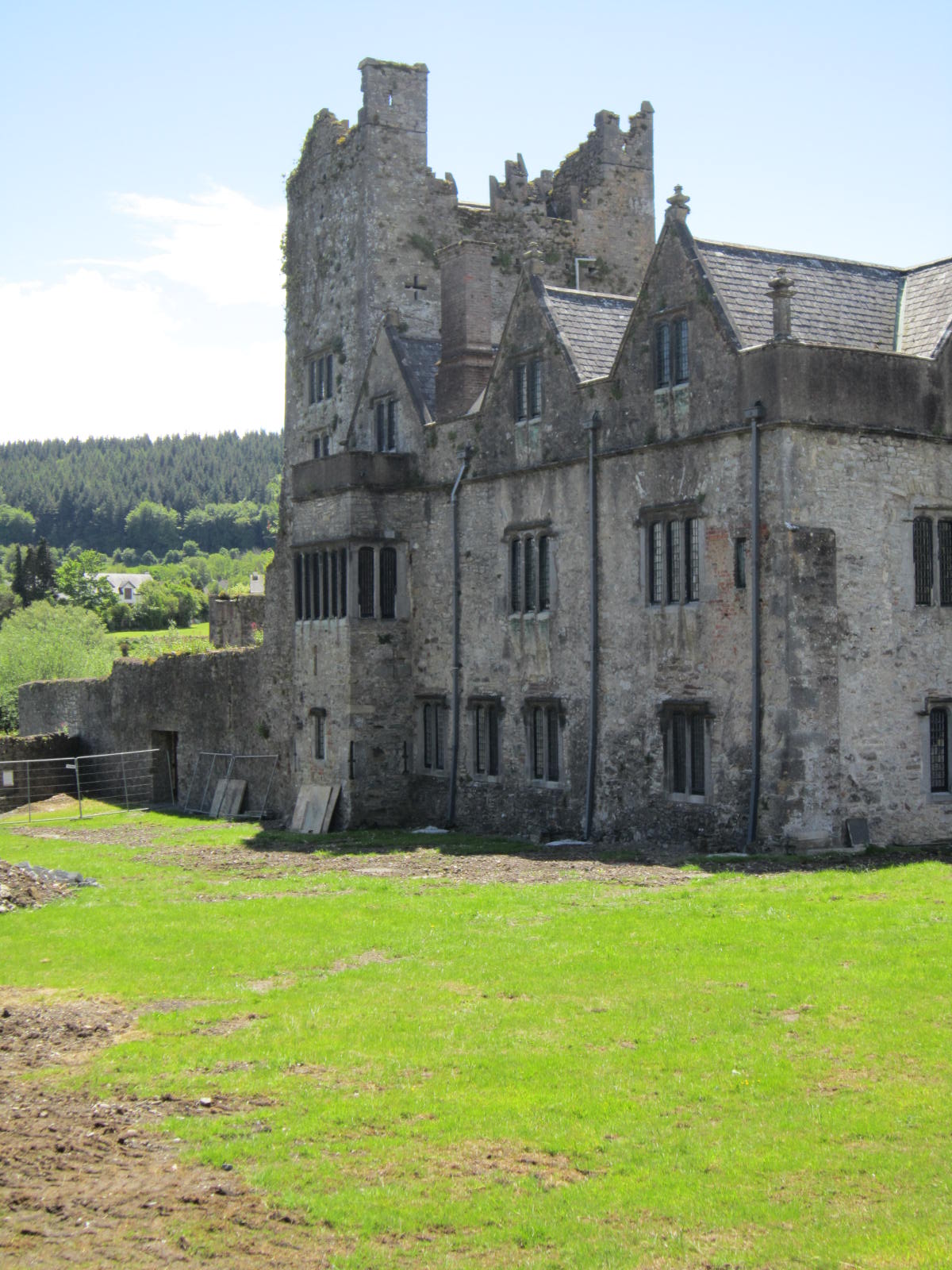 It is always thrilling to be in Ireland, although during my research trip there were some disappointments. The greatest of these was finding Carrick on Suir, (now known as Ormonde Castle to distinguish it from the town), closed for renovations for the entire year. My advance research somehow did not disclose this, so upon arrival, all I could do was walk around all sides, take pictures, and use my imagination.
It is always thrilling to be in Ireland, although during my research trip there were some disappointments. The greatest of these was finding Carrick on Suir, (now known as Ormonde Castle to distinguish it from the town), closed for renovations for the entire year. My advance research somehow did not disclose this, so upon arrival, all I could do was walk around all sides, take pictures, and use my imagination.
[As of this writing, the castle remains closed to visitors due to renovations, but is scheduled to reopen in June, 2017.]
Situated along the River Suir on the east side of the village in County Tipperary, this castle exudes history. It is remarkable for being Ireland’s only unfortified manor house from the Tudor period, and for the quality of plasterworks within. On the river side you see a classic 14th century castle with two towers, east and west, but then it is knitted together on the upland side with a majestic Tudor mansion. (See a tour video here.)
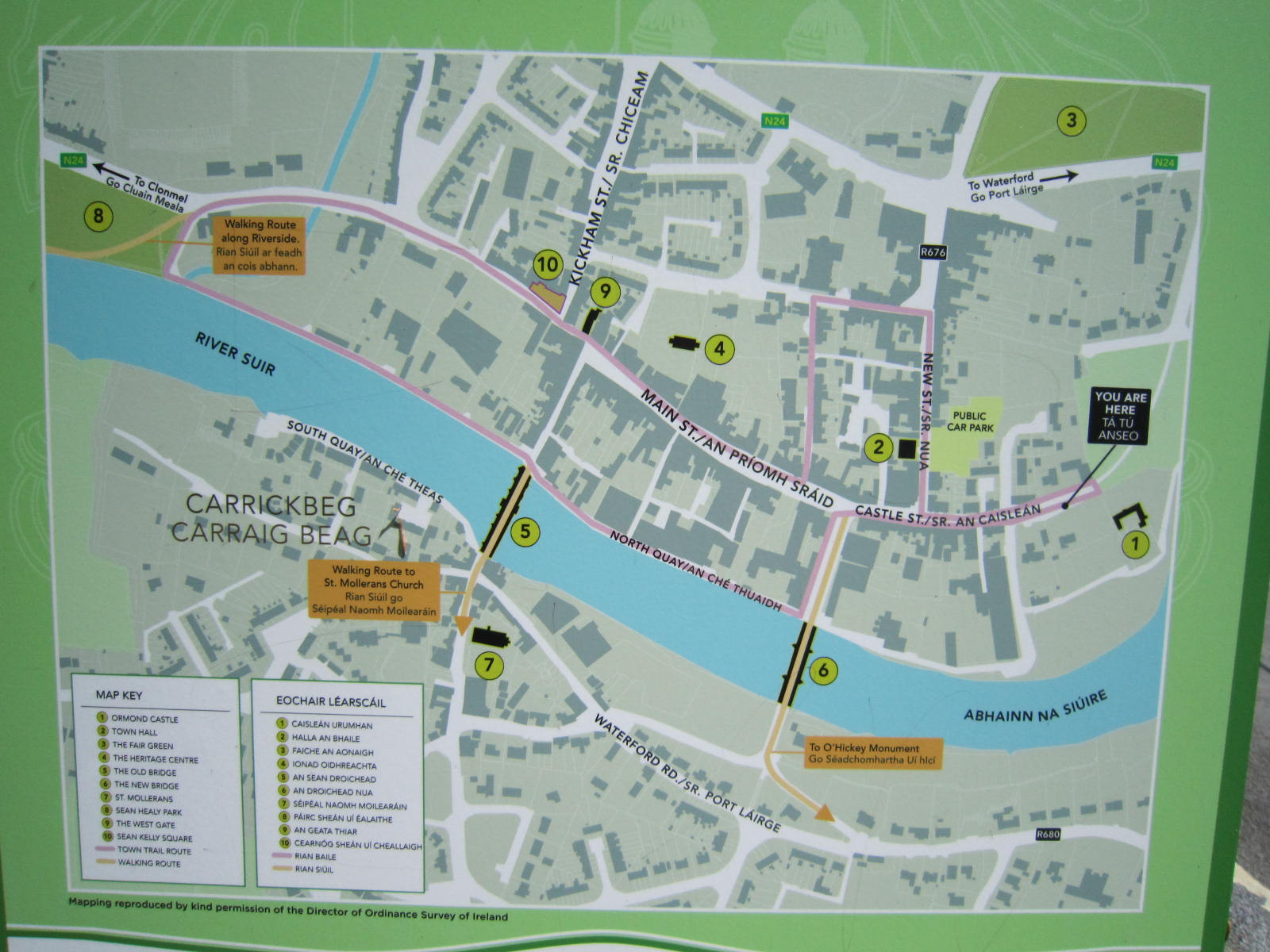
Carrick means bend or knot, and may have originally referred to the location along a bend in the river, but there is also a famous “carrick knot,” a rope knot having open-ended loops, symbolizing the nautical knot used by boatmen who worked along the river.
The most charming feature of this castle is the mullioned Tudor windows with their many small panes known as “quarries.” There are so many of these beautiful windows, and at one point I could see light all the way through to the opposite side of the house. It’s a rare thing to see a castle that so embraces the daylight. (For more about the history of windows in Ireland, see this wonderful site.)
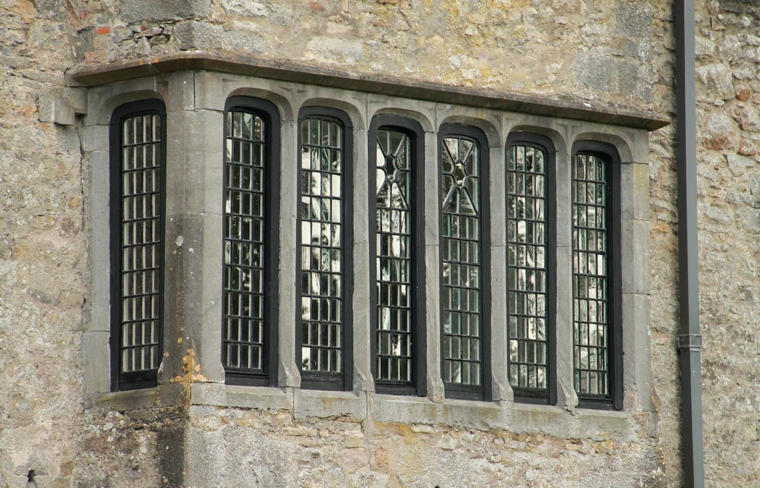
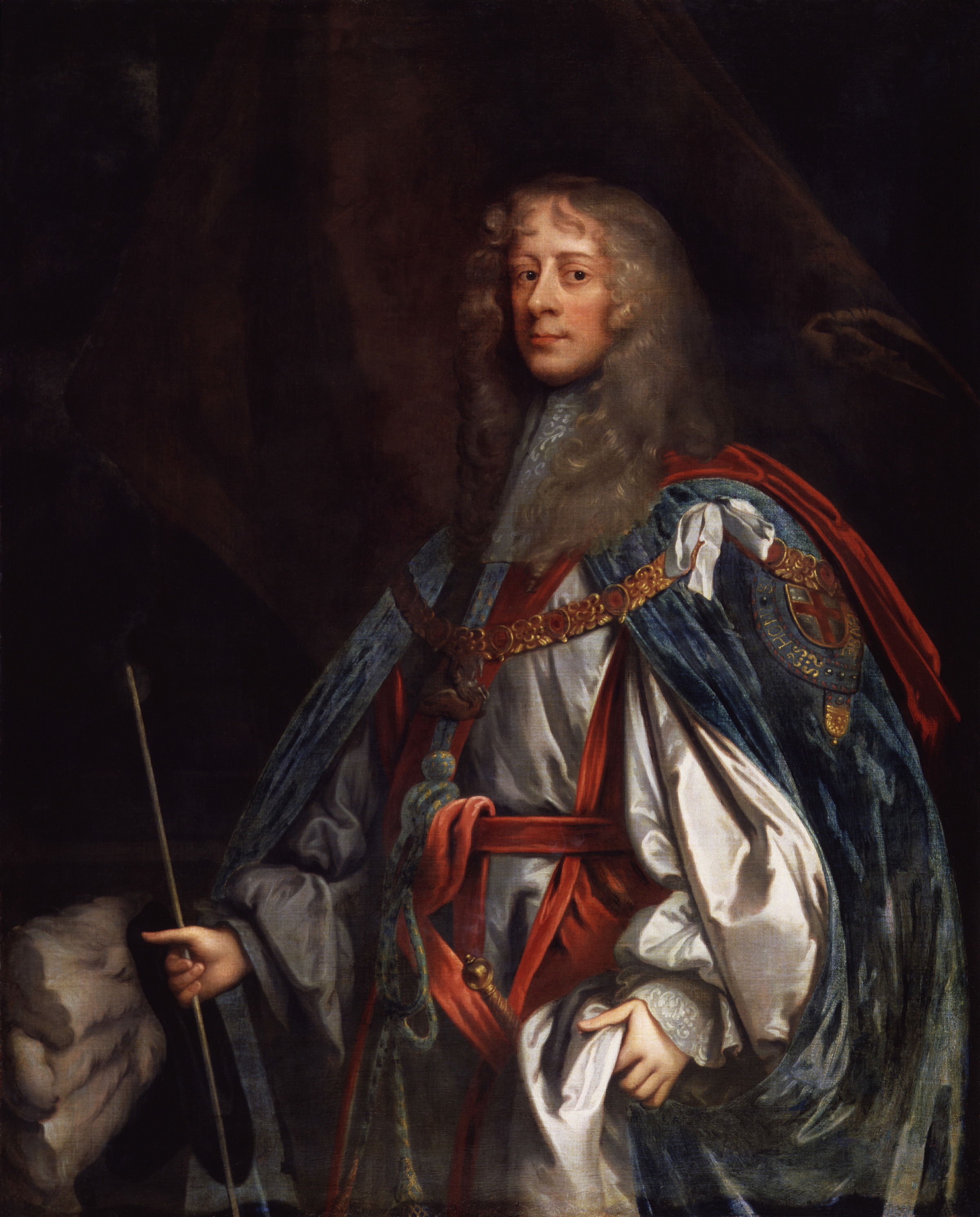
Built by Thomas Butler, the 10th Earl of Ormonde (and Queen Elizabeth’s cousin), in the 1560s, the manor house became the preferred residence of James Butler, 12th Earl of Ormonde, later the first Duke of Ormonde, during the 17th century. This is truly saying something, for the Butlers were the second-largest landholders in Ireland and their properties included more than 30 manors and houses. Among their holdings was the famous Kilkenny castle, the seat of power for the Butler family.
The story goes that, shortly before Thomas died, four-year-old James was playing behind the earl's chair. The old man held the child between his knees and prophesied, "My family shall be much oppressed and brought very low; but by this boy it shall be restored again, and in his time be in greater splendor than ever it has been." Later events proved the earl's prophesy to be true, for when James ascended to the earldom he became known as a valiant and honest man, was highly respected by all sides and, among other things he founded the woolen industry. James led the Irish confederates against Oliver Cromwell's Parliamentary forces in the mid-17th century, and subsequently lost much of the family's property and wealth, but it was restored during the restoration of King Charles II, and James was created Duke of Ormonde for his loyalty and service to the crown.
Ormond Castle interiors were known for their magnificent plasterwork, and for grand tapestries adorning the walls of the great hall. In my book, The Prince of Glencurragh, a scene takes place in Ormonde Castle, where the Earl, James Butler, receives young messenger Aengus O’Daly who is awestruck by the beauty of the hall and these tapestries, and humbled by the many representations of royalty and power. (I saved a couple of interior images to my Pinterest page on Ireland, but can't post them here. Follow me there for these and other images.)
 An heiress, a castle, a fortune: what could go wrong?
An heiress, a castle, a fortune: what could go wrong?
The Prince of Glencurragh is available in ebook, soft cover and hard cover from online booksellers.
https://books2read.com/u/4N1Rj6
http://www.amazon.com/Prince-Glencurragh-Novel-Ireland-ebook/dp/B01GQPYQDY/
See all of my books and other information at nancyblanton.com
 Excitement was to be replaced by disappointment when I first reached the gates of Barryscourt Castle in Carrigtwohill, County Cork. Driving solo from Cashel, I got a bit lost in the vicinity—often there are not good signs, if any, to indicate castle locations—but a petrol station attendant smiled and told me I was just a few blocks away. When I parked, two workmen told me the castle was closed for renovations, but the owner was in the adjacent house and I could tour the gardens briefly if I liked.
Excitement was to be replaced by disappointment when I first reached the gates of Barryscourt Castle in Carrigtwohill, County Cork. Driving solo from Cashel, I got a bit lost in the vicinity—often there are not good signs, if any, to indicate castle locations—but a petrol station attendant smiled and told me I was just a few blocks away. When I parked, two workmen told me the castle was closed for renovations, but the owner was in the adjacent house and I could tour the gardens briefly if I liked.
As of this writing, the Heritage Ireland website says the castle is closed “until further notice,” so if you want to see the interiors, you may have to rely on other visitor photos, such as the ones in this TripAdvisor site.
 Consequently, there is no scene in The Prince of Glencurragh that is set in Barryscourt Castle. I circled the great Norman tower twice as if hoping to find a secret passage, and then focused on the magnificent garden. Plaques were placed about so that I could identify the plants within the castle walls, a feature that is extremely helpful to an author who lives in another country and manages best with the silk plant variety.
Consequently, there is no scene in The Prince of Glencurragh that is set in Barryscourt Castle. I circled the great Norman tower twice as if hoping to find a secret passage, and then focused on the magnificent garden. Plaques were placed about so that I could identify the plants within the castle walls, a feature that is extremely helpful to an author who lives in another country and manages best with the silk plant variety.
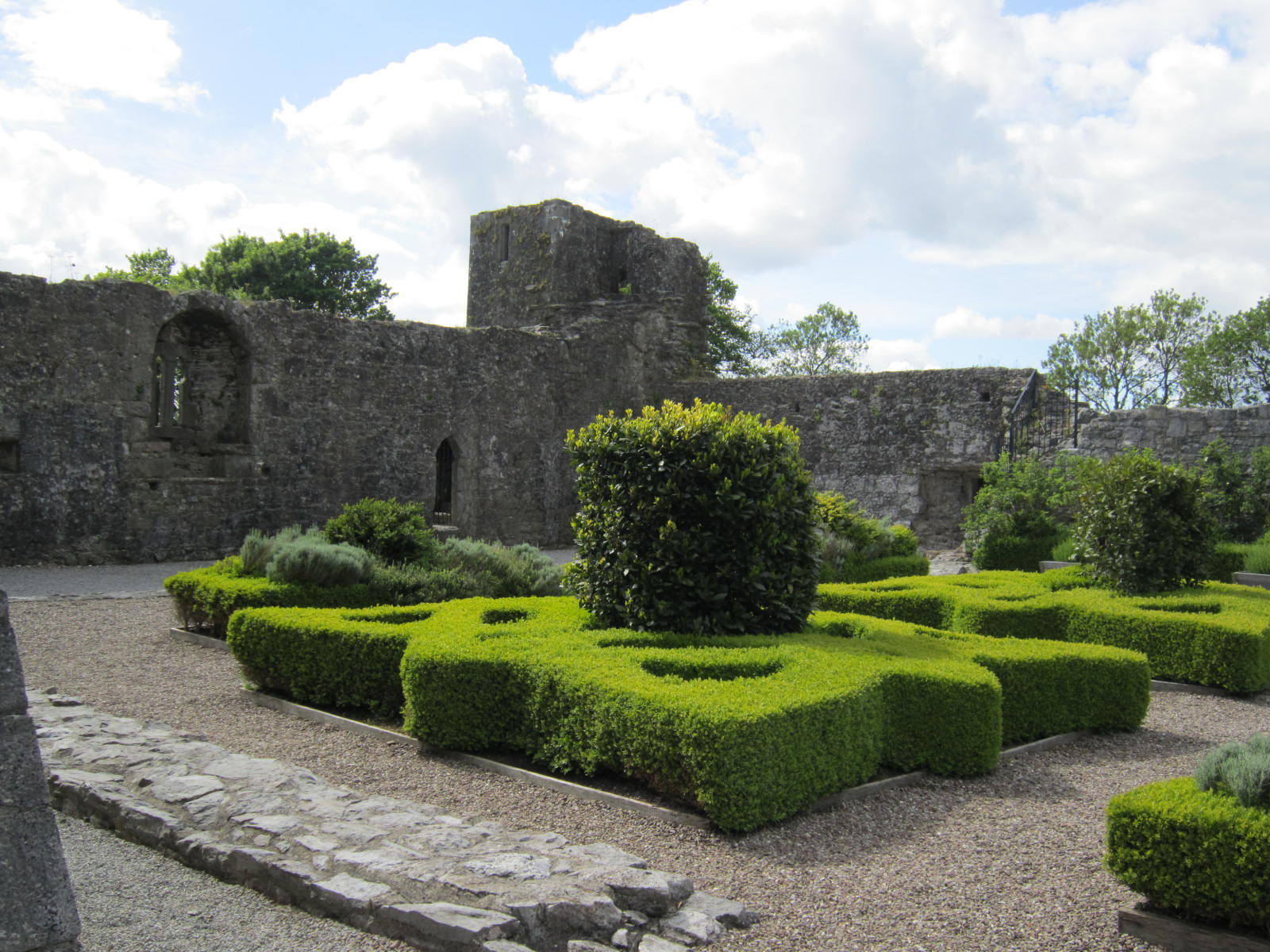 The original castle was built in the 12th century, and the structure I saw was dated for about 1550. The architecture is described as a typical tower house with courtyard and outer bawn or curtain wall, and a “drop-the-prisoner-in-from-the-top” type of dungeon. From the grounds, the castle has the look and feel of the ancient and romantic. I could almost feel the long courtly gown about me, sense the workers bustling in the yard, and imagine stepping through the great wooden door and then ascending a stone stairway to a room in the tower warmed by fire.
The original castle was built in the 12th century, and the structure I saw was dated for about 1550. The architecture is described as a typical tower house with courtyard and outer bawn or curtain wall, and a “drop-the-prisoner-in-from-the-top” type of dungeon. From the grounds, the castle has the look and feel of the ancient and romantic. I could almost feel the long courtly gown about me, sense the workers bustling in the yard, and imagine stepping through the great wooden door and then ascending a stone stairway to a room in the tower warmed by fire.
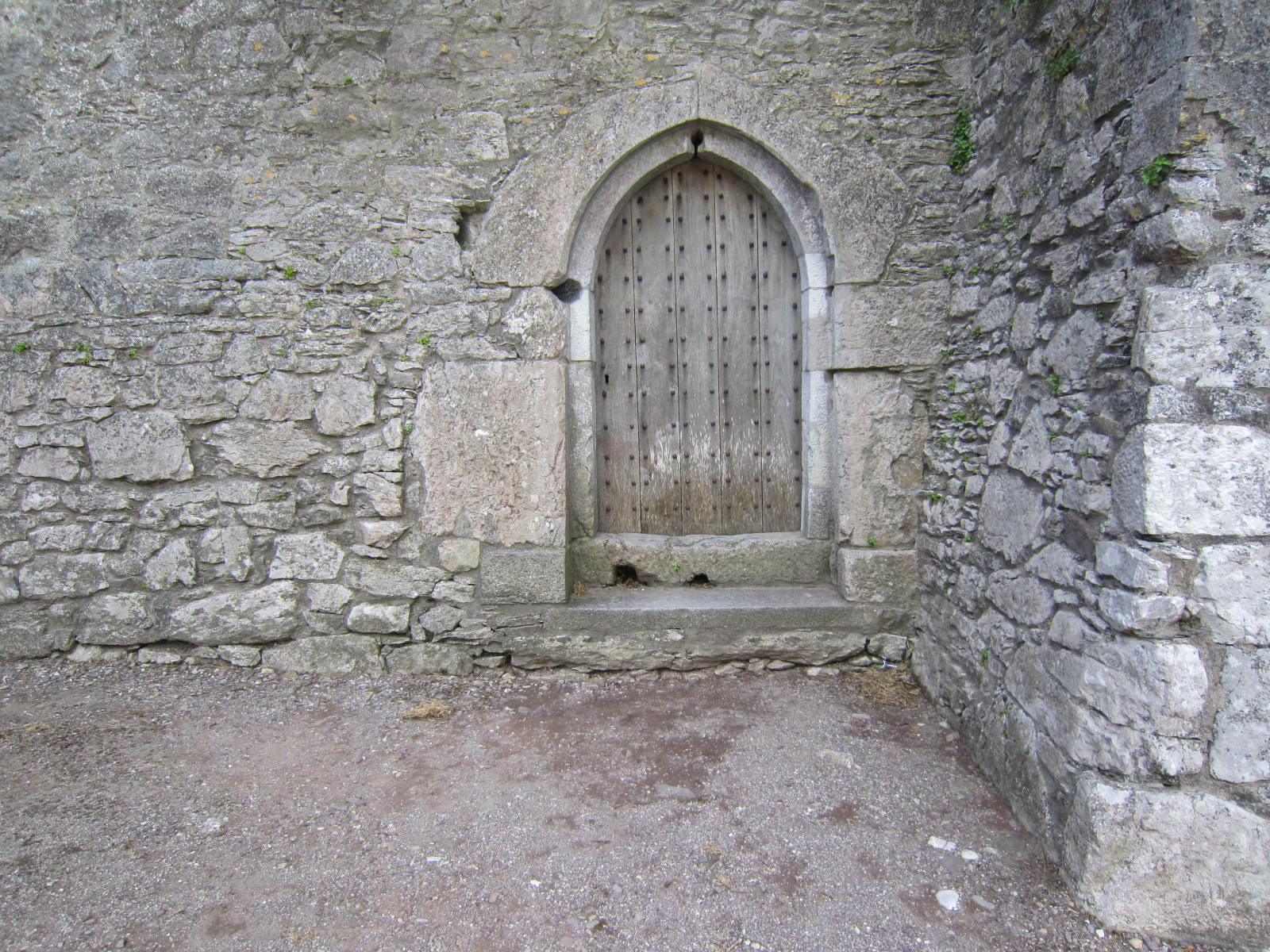 Here had been the seat of the noble de Barry family, to whom King John in the 12th century awarded baronies in South Munster province in return for service in the Norman invasion of Ireland. In this time, English landholders often intermarried with the Irish and relished their autonomy, so far removed from the king’s influence. In later years, when Henry VIII wanted to exert his authority, the Barrys supported the Desmond Rebellions. In 1680 they set fire to Barryscourt themselves rather than see it captured by Sir Walter Raleigh and his English troops. But the Barrys later submitted, and Queen Elizabeth pardoned them after the rebellions were suppressed. Barryscourt was repaired, but external walls still bear the scars of cannon fire.
Here had been the seat of the noble de Barry family, to whom King John in the 12th century awarded baronies in South Munster province in return for service in the Norman invasion of Ireland. In this time, English landholders often intermarried with the Irish and relished their autonomy, so far removed from the king’s influence. In later years, when Henry VIII wanted to exert his authority, the Barrys supported the Desmond Rebellions. In 1680 they set fire to Barryscourt themselves rather than see it captured by Sir Walter Raleigh and his English troops. But the Barrys later submitted, and Queen Elizabeth pardoned them after the rebellions were suppressed. Barryscourt was repaired, but external walls still bear the scars of cannon fire.

In The Prince of Glencurragh, my focus is on David, the first earl of Barrymore, who fell to obscurity after the Desmond wars, and was rescued from it by the Earl of Cork who saw a noble-blooded match for his young daughter, Lady Alice. David would later build Castle Lyons, a reputedly beautiful castle that became the Barry seat in 1617, but burned down in 1771. In the novel, this earl has promised to support the protagonist, narrator, and two Barry relatives in their abduction of an heiress for the protagonist to wed.
The Barrymore titles in Ireland became extinct after the death of the last earl in 1823. But the name is not extinct at all to Americans, who are familiar with the names if not the theatrical careers of Maurice, his children Lionel, Ethel, and John, grandson John, and great-granddaughter Drew. While they might have owned castles, these Barrymores are not descended from the Irish clan. Born in British India, Maurice Blyth took his stage name Barrymore as his surname when he immigrated to the United States from England in 1874.
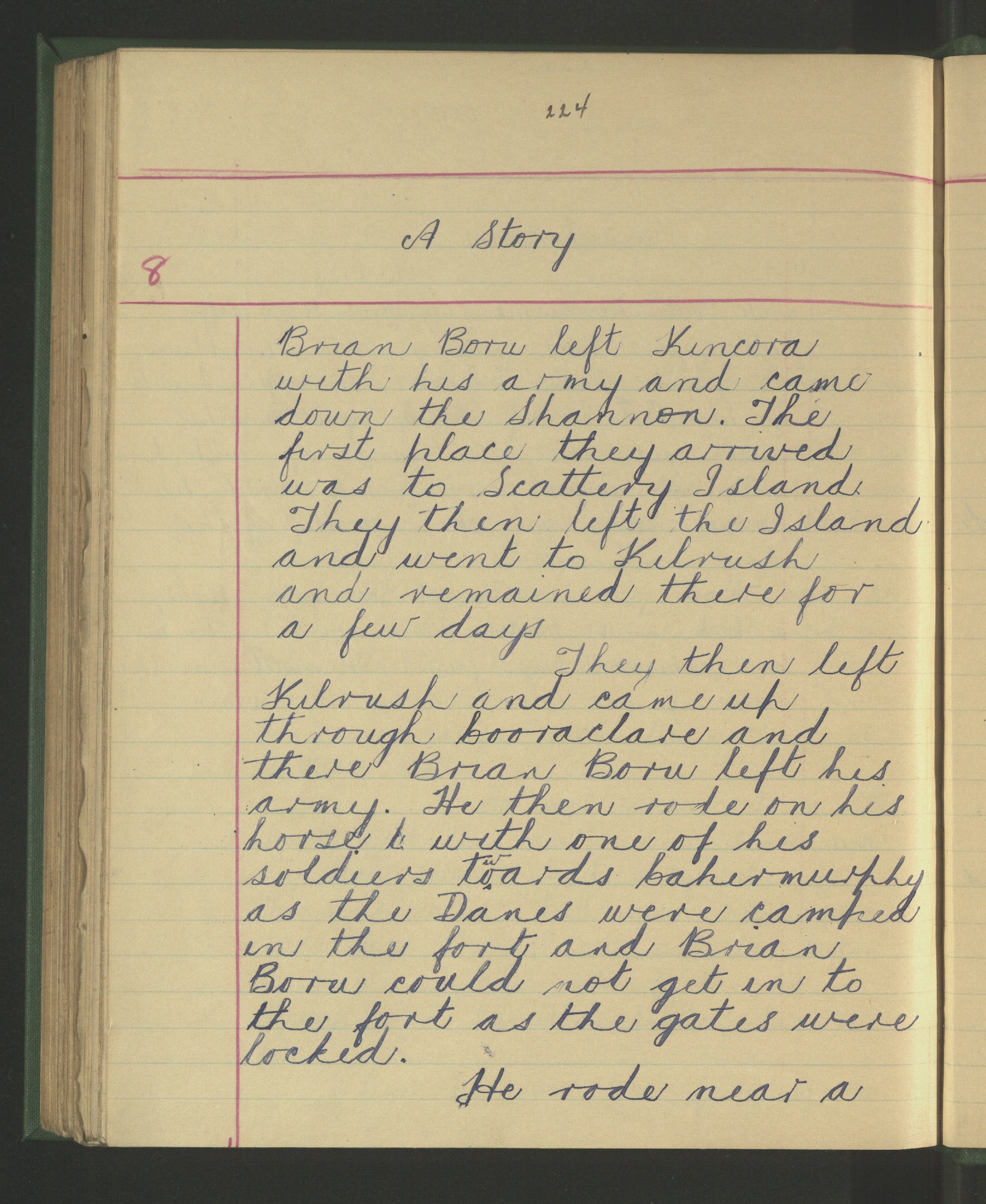 Perhaps as consolation for not getting to tour Barryscourt, in my research I stumbled across this site, http://www.duchas.ie/en, which is digitizing the national folklore collection of Ireland. It’s not an easy browse for gems, i.e. no photo gallery, but you can find handwritten accounts of people, events and places from Ireland’s own. I downloaded part of a story about Brian Boru, the famous Irish king of the 10th century, written by a schoolgirl, and realized even her cursive handwriting is a treasure, soon perhaps to go the way of tower house castles, and my mother’s shorthand.
Perhaps as consolation for not getting to tour Barryscourt, in my research I stumbled across this site, http://www.duchas.ie/en, which is digitizing the national folklore collection of Ireland. It’s not an easy browse for gems, i.e. no photo gallery, but you can find handwritten accounts of people, events and places from Ireland’s own. I downloaded part of a story about Brian Boru, the famous Irish king of the 10th century, written by a schoolgirl, and realized even her cursive handwriting is a treasure, soon perhaps to go the way of tower house castles, and my mother’s shorthand.
 An heiress, a castle, a fortune: what could go wrong?
An heiress, a castle, a fortune: what could go wrong?
The Prince of Glencurragh is available in ebook, soft cover and hard cover from online booksellers.
https://books2read.com/u/4N1Rj6
http://www.amazon.com/Prince-Glencurragh-Novel-Ireland-ebook/dp/B01GQPYQDY/
 After a cup of tea and a lemon bar in Kanturk, I proceeded east on the N72/N8 to the town of Cashel (from the Gaelic caiseal meaning stone fort), in County Tipperary. I’d been to Cashel with my family when I was 14 years old, to see the great Rock of Cashel: “a maze of architectural ruins spanning many centuries” according to the Irish Cultural Society.
After a cup of tea and a lemon bar in Kanturk, I proceeded east on the N72/N8 to the town of Cashel (from the Gaelic caiseal meaning stone fort), in County Tipperary. I’d been to Cashel with my family when I was 14 years old, to see the great Rock of Cashel: “a maze of architectural ruins spanning many centuries” according to the Irish Cultural Society.
I remembered little about this historical site except that the great cathedral was enormous, the structures intimidating, and all built on a rock promontory rising more than 300 feet high to overlook miles of lands that surrounded it. Impressive story, yes, and unforgettable architecture, to be sure, but now I needed specifics about its history, its layout and many more details.
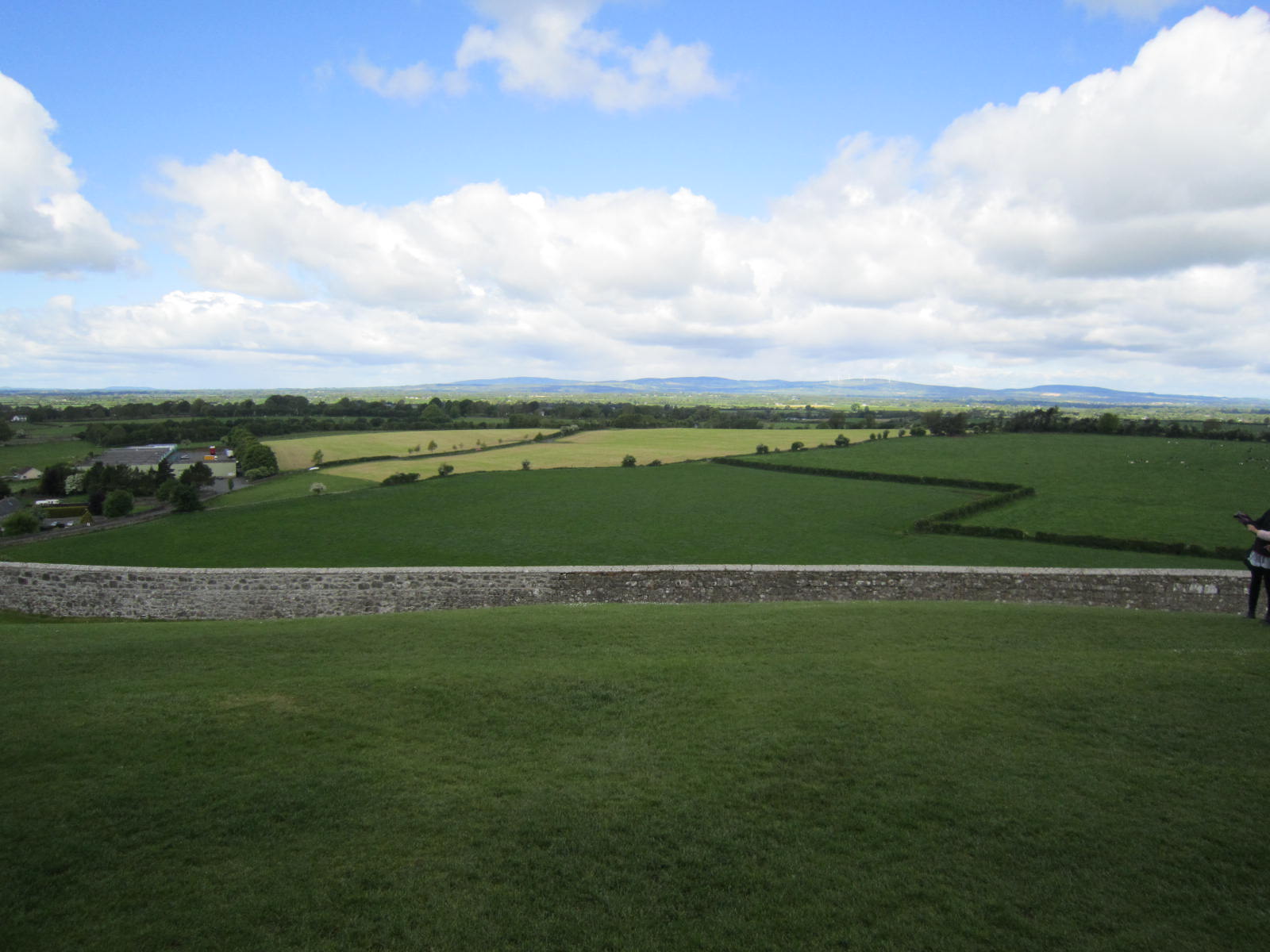
Centrally located in the southern half of Ireland, legend has it that the promontory was created when the Devil took a bite out of a nearby mountain and the great chunk of rock fell from his mouth. Structures at this location date back to the fourth century, and later the Rock of Cashel became the seat of the Munster kings, including Brian Boru who in the 10th century unified all of Ireland under his rule—until 1014 when Vikings killed his son and him at Clontarf.
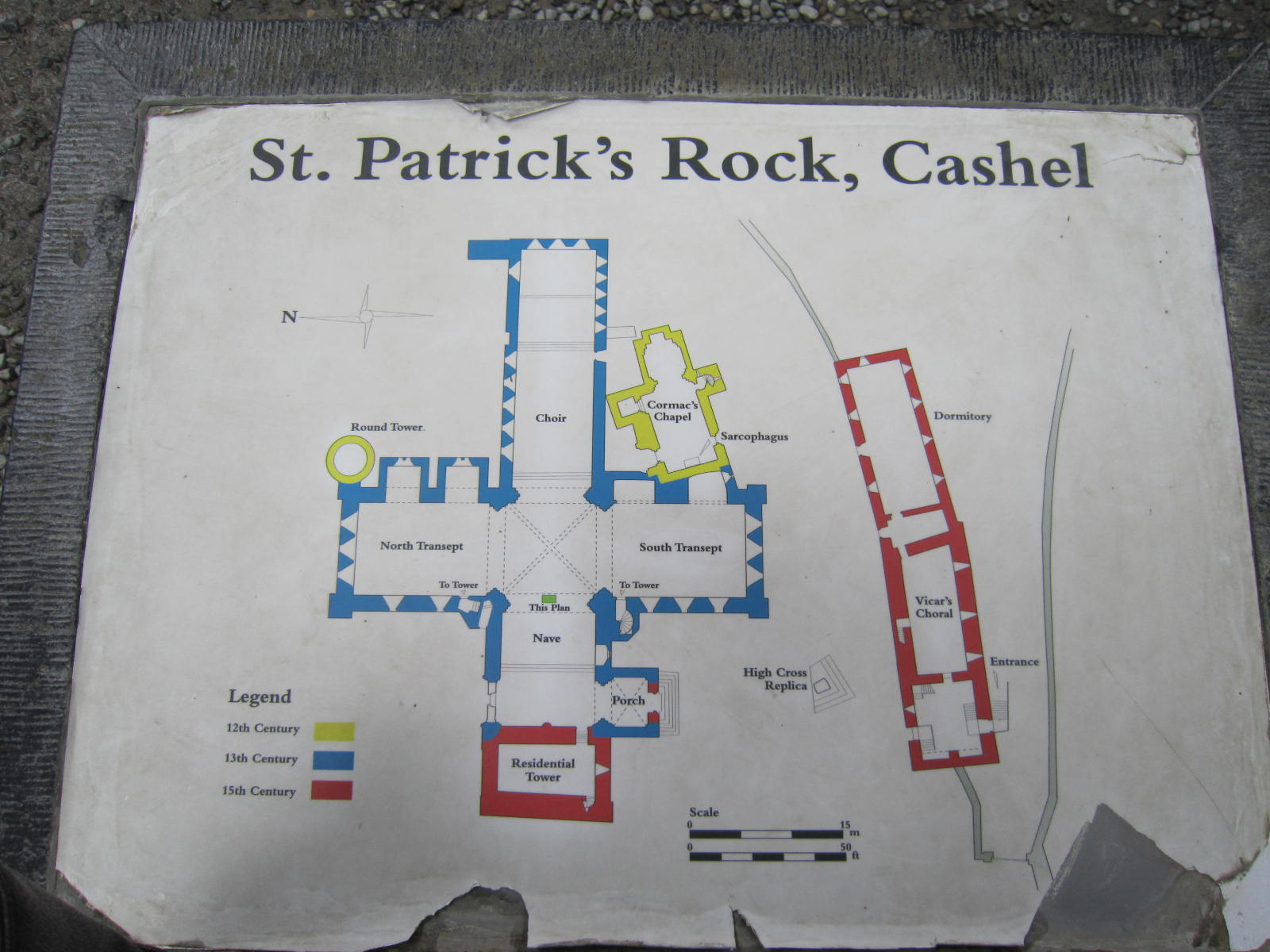
The round tower, built in 1101, was designed for protection from Vikings, with its door 12 feet off the ground and a ladder that could be pulled inside in case of attack. Cormac’s tiny chapel was started in 1127.
In the late 13th century, the site was deeded to the Catholic Church, and Saint Patrick’s Cathedral was built on the foundation of an older one. After King Henry VIII split from the Catholic Church and established the Church of England, he appointed his own bishops, as did his daughter Queen Elizabeth in later years.
“In the wind swept silence one can feel the spirit of the ancient chieftains, kings and bishops of Ireland who once lived and worked here.” --James Conroy
After the English civil war when Parliament emerged victorious and King Charles I was beheaded, Oliver Cromwell brought his army to Ireland to crush the Irish rebellion once and for all. Starting in Drogheda in 1649, his march was brutal and bloody, and the cruelty of it remains controversial even today. Cashel was one of several villages sacked by Cromwell’s troops. When Catholic soldiers and town’s people sought refuge in the cathedral, Cromwell recognized no sanctuary, ordered his troops to pile turf around the cathedral and set it afire, killing all within.
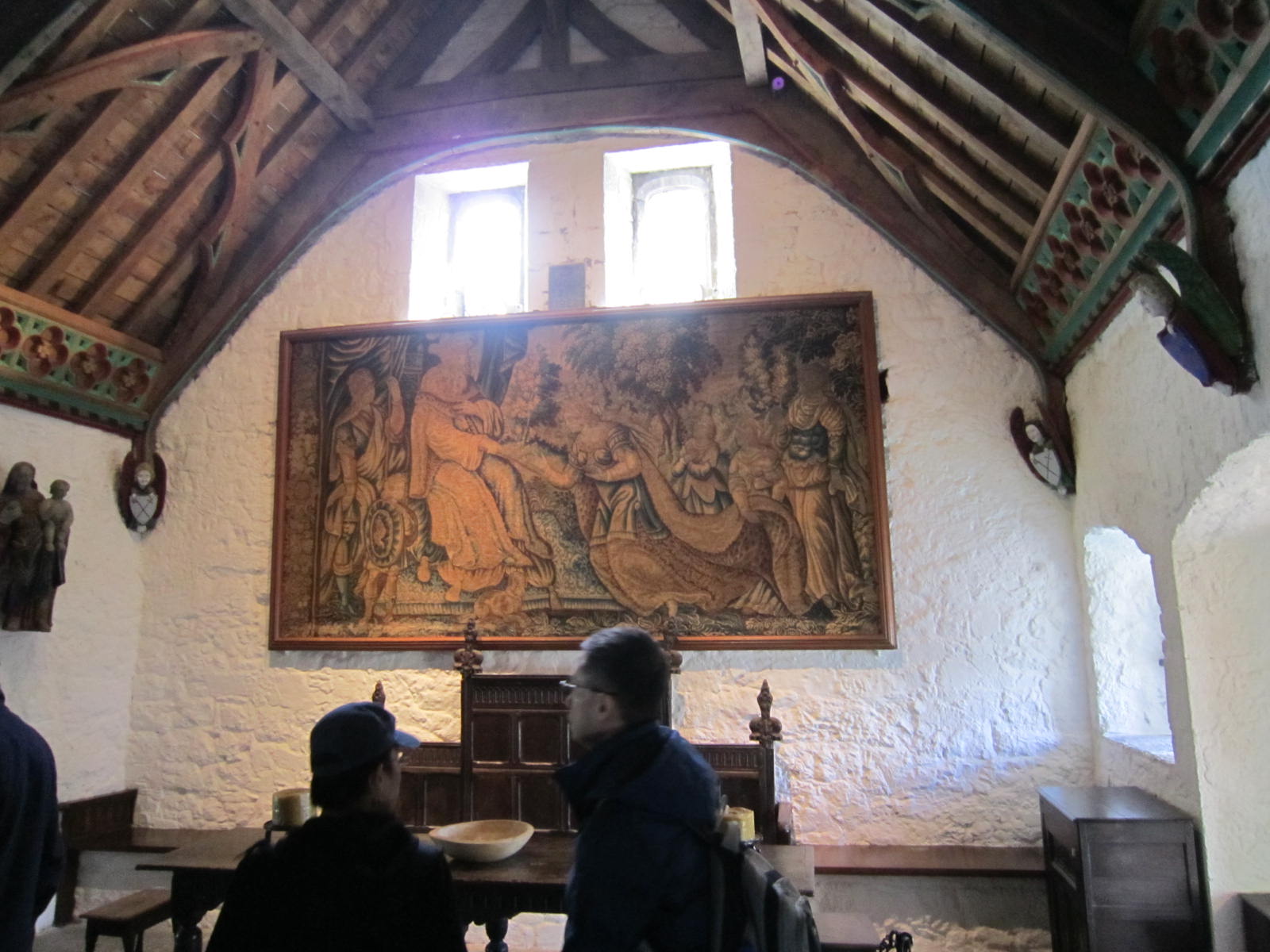
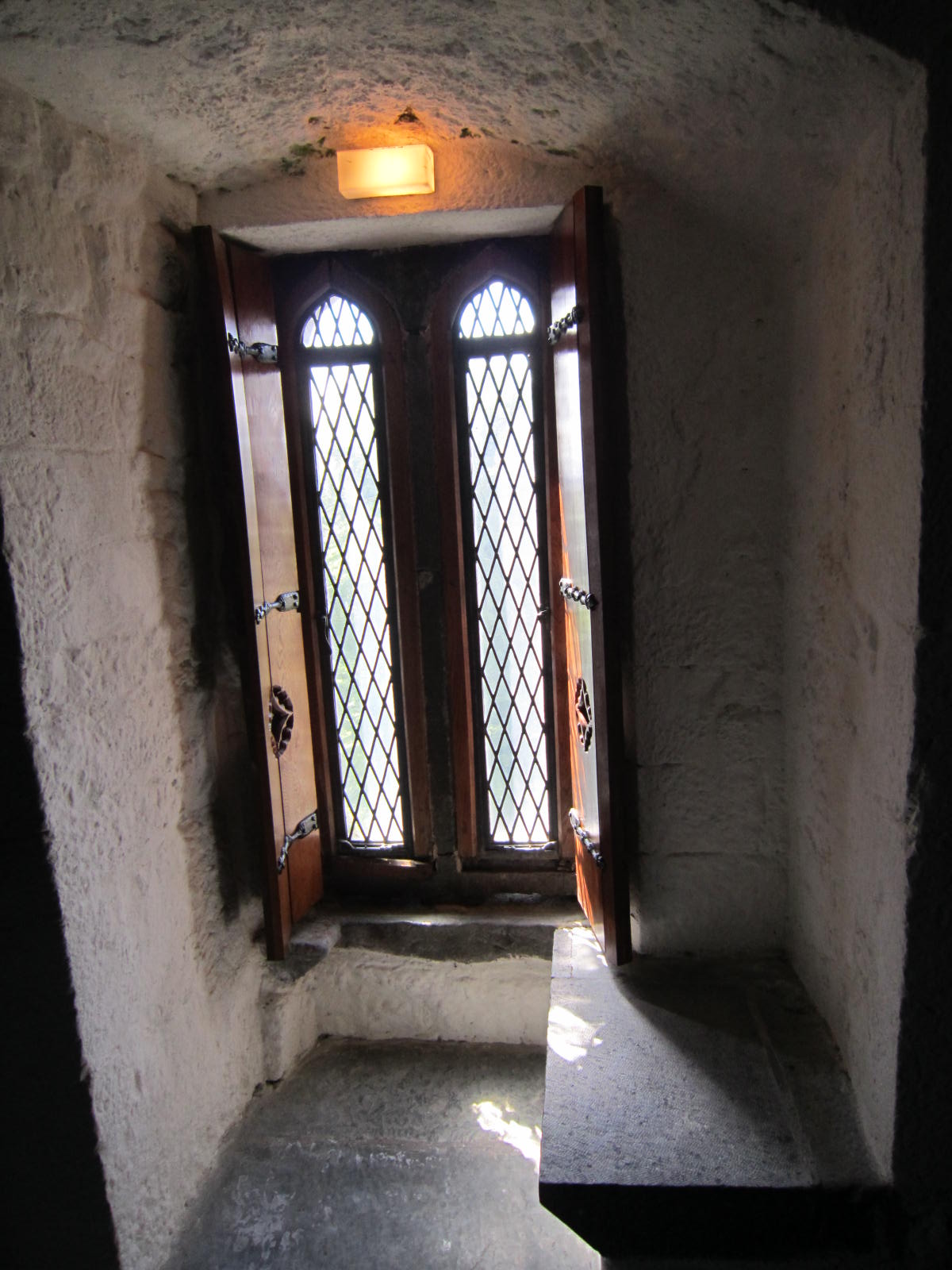 Across the courtyard from the cathedral is the vicar’s choral, including kitchen and dining hall for the men who assisted with cathedral services. This has been restored to serve as a museum. The dining hall is quite beautiful with dark ceiling beams, leaded windows and window seats, trestle table and tapestry. This choral became the setting for the mid-point scene in The Prince of Glencurragh, when the earls of Clanricarde, Ormonde and Cork come together to meet with the Lord Deputy of Ireland, Thomas Wentworth, who quickly takes control. Where the roof joins the walls, the decorative under-purlins are carved angels who look down on all below, and whose facial expressions add their own silent commentary.
Across the courtyard from the cathedral is the vicar’s choral, including kitchen and dining hall for the men who assisted with cathedral services. This has been restored to serve as a museum. The dining hall is quite beautiful with dark ceiling beams, leaded windows and window seats, trestle table and tapestry. This choral became the setting for the mid-point scene in The Prince of Glencurragh, when the earls of Clanricarde, Ormonde and Cork come together to meet with the Lord Deputy of Ireland, Thomas Wentworth, who quickly takes control. Where the roof joins the walls, the decorative under-purlins are carved angels who look down on all below, and whose facial expressions add their own silent commentary. 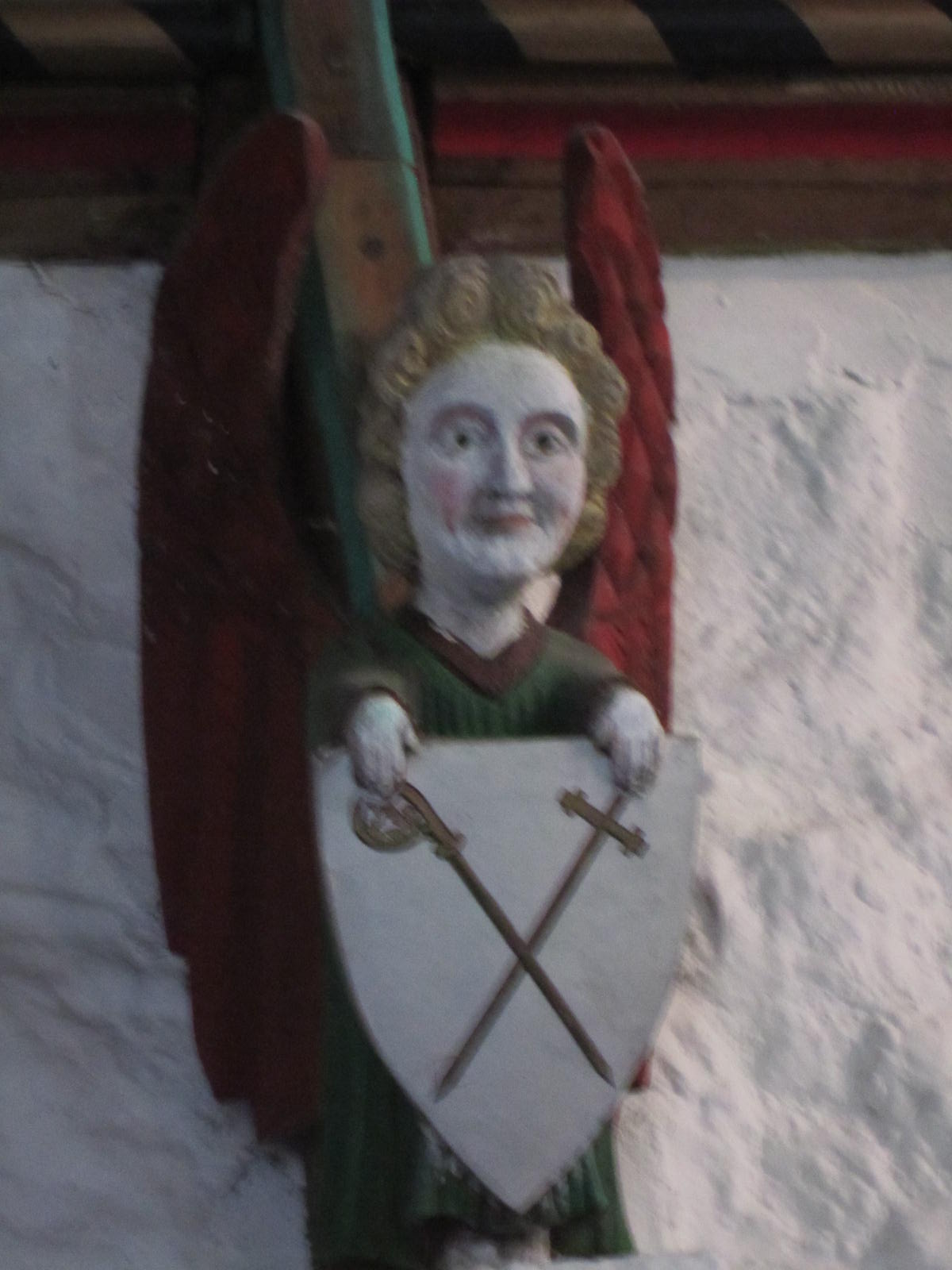
In the mid 18th century the Archbishop had the cathedral’s roof removed. Its lead content was considered valuable in that it could be used for ammunition, and alchemists of the time believed it possibly could be transformed into gold if the right process or catalyst was applied, because both gold and lead have similar properties. That controversial move left the site useful only as a tourist attraction. As this, however, the site is quite successful. Cashel is one of the top three centers of Irish culture.
For beautiful architecture, you may also want to visit the Dominican Friary tucked on the backstreets of the town of Cashel.
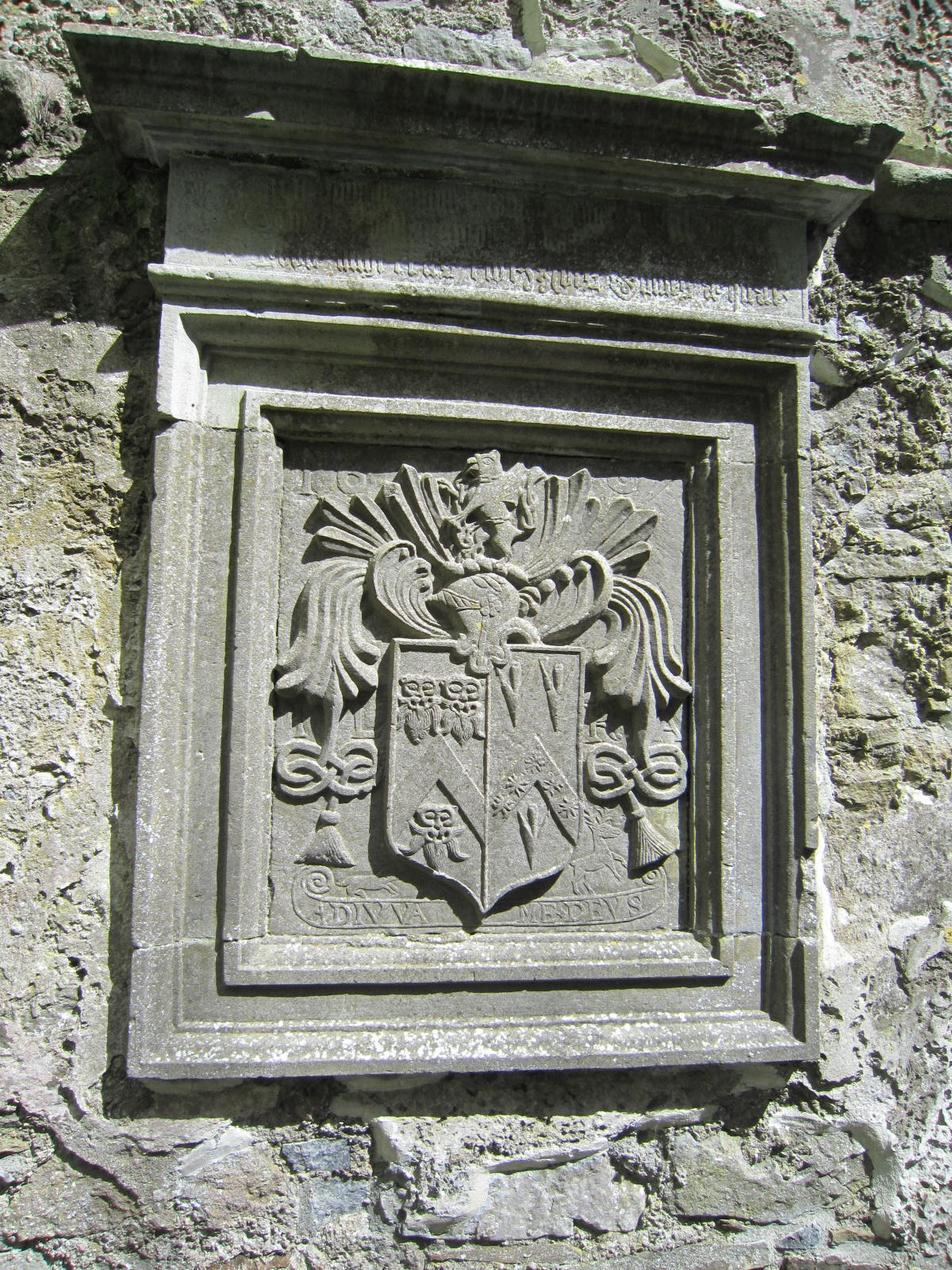 And a side note: While in Cashel I tried to visit Bothán Scór, a peasant cottage known locally as “Hanley’s,” that traces its history back to 1623. I hoped to see an accurate example of cottage life from that time. The tiny thatch-roofed cottage had a single window but it was blocked, preventing my view inside. You can see the cottage from the street, but according to the tourist office only one man has a key to the door, and they were unable to find him before I had to leave the town. This was the first of a few unfortunate missed opportunities during my travels. If you go and are able to see it, please tell me about it!
And a side note: While in Cashel I tried to visit Bothán Scór, a peasant cottage known locally as “Hanley’s,” that traces its history back to 1623. I hoped to see an accurate example of cottage life from that time. The tiny thatch-roofed cottage had a single window but it was blocked, preventing my view inside. You can see the cottage from the street, but according to the tourist office only one man has a key to the door, and they were unable to find him before I had to leave the town. This was the first of a few unfortunate missed opportunities during my travels. If you go and are able to see it, please tell me about it!
 An heiress, a castle, a fortune: what could go wrong?
An heiress, a castle, a fortune: what could go wrong?
The Prince of Glencurragh is available in ebook, soft cover and hard cover from online booksellers.
https://books2read.com/u/4N1Rj6
http://www.amazon.com/Prince-Glencurragh-Novel-Ireland-ebook/dp/B01GQPYQDY/
See all my books and sign up for the newsletter here.

Today I begin a series featuring sites I visited in Ireland while researching my second novel, The Prince of Glencurragh. This book takes place in mid-17th century Ireland, when castle towers are losing their significance and the order of the day for the rich and powerful is a grand, fortified manor house that demonstrates their wealth and importance. I had mapped out 15 locations prior to my trip, so the series will cover each of these. Readers of The Prince can follow along using the map included in the book. I ended up using nearly all of the locations in some way, whether as an actual location for a scene in the story, or to inform something else.
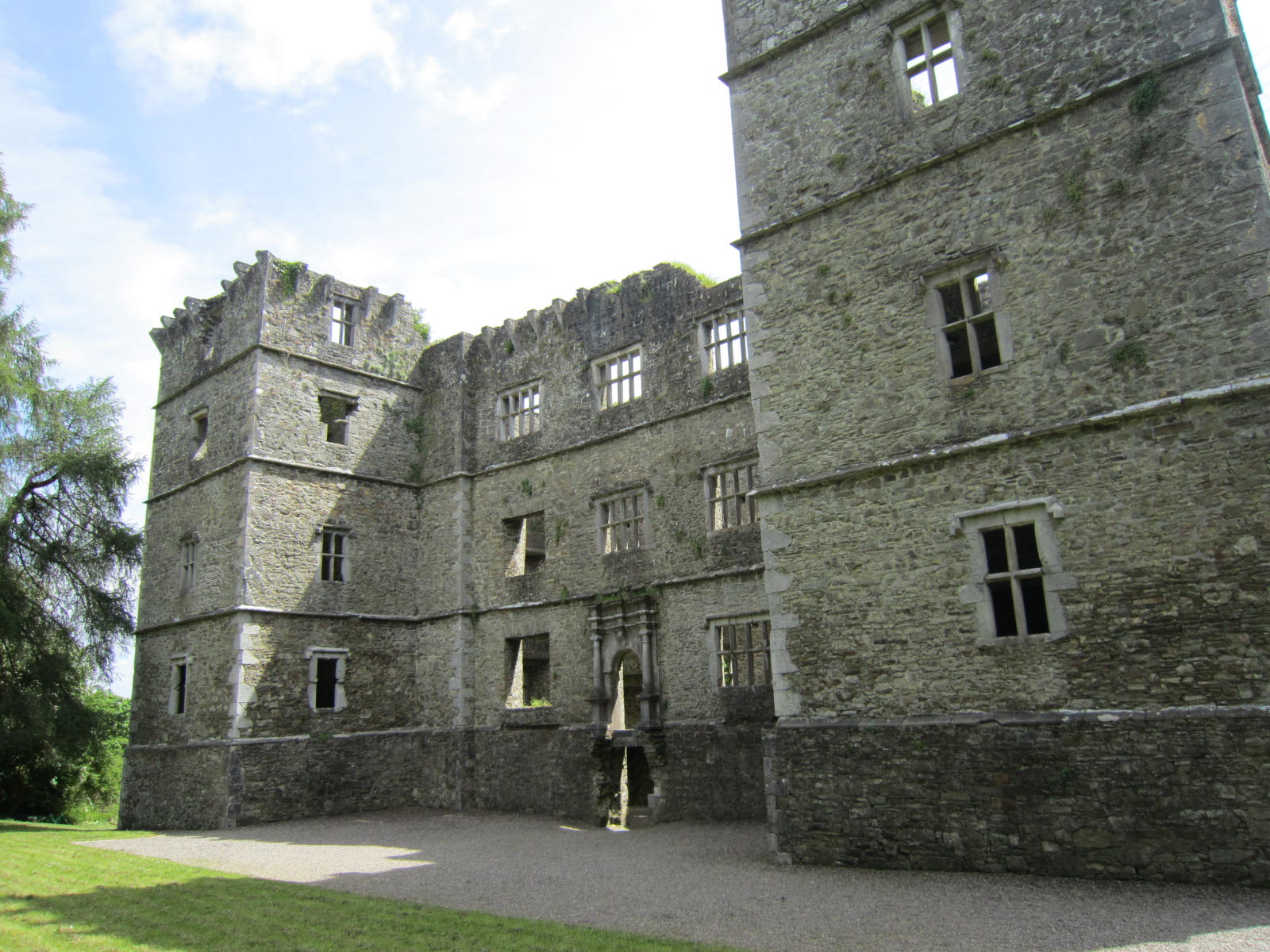 Kanturk Castle was my first stop after arriving in Shannon. The structure inspired my vision for Castle Glencurragh, a fictitious castle near Skibbereen, County Cork, which is the dream and ambition of the protagonist.
Kanturk Castle was my first stop after arriving in Shannon. The structure inspired my vision for Castle Glencurragh, a fictitious castle near Skibbereen, County Cork, which is the dream and ambition of the protagonist.
Kanturk Castle is situated in north County Cork, just off the N72 about nine miles west of Mallow, along the Dalua river, a tributary of the Blackwater. It is named for the nearby market village Kanturk that existed centuries before the castle. While the name sounds exotic and mysterious, it actually means “the boar’s head” (from the Gaelic Ceann Tuirc).
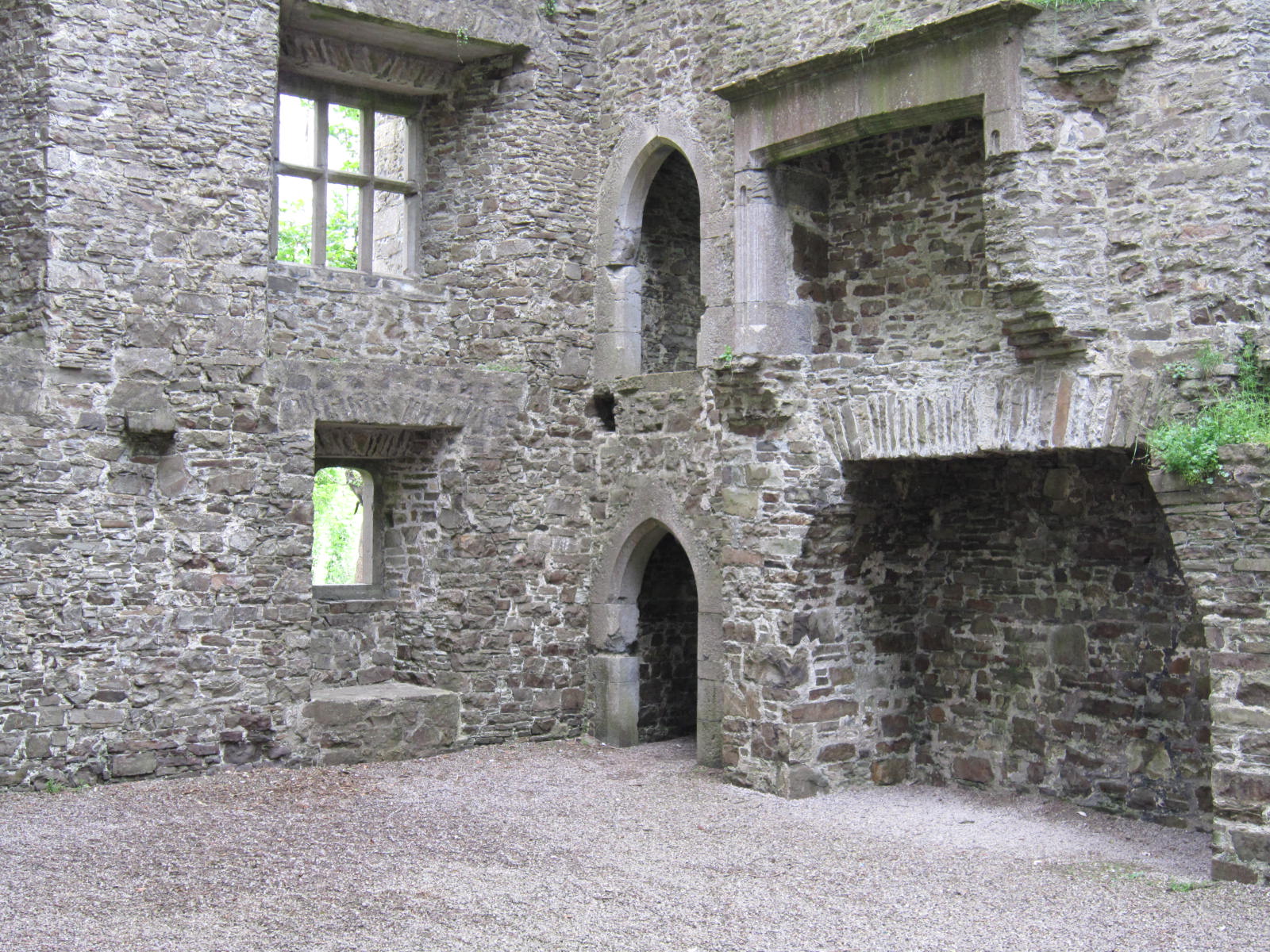 To me, the remarkable thing about this enormous and beautiful fortified manor house, and why I felt compelled to see it, is that it was the envy of all who saw it during construction, and yet it was never completed.
To me, the remarkable thing about this enormous and beautiful fortified manor house, and why I felt compelled to see it, is that it was the envy of all who saw it during construction, and yet it was never completed.
Built by Dermot McDonagh MacCarthy starting around 1609, it is rectangular with corner towers standing five stories high. It is filled with magnificent fireplaces on each floor, large mullioned windows, arched doorways and a striking main entrance with Ionic columns on each side.
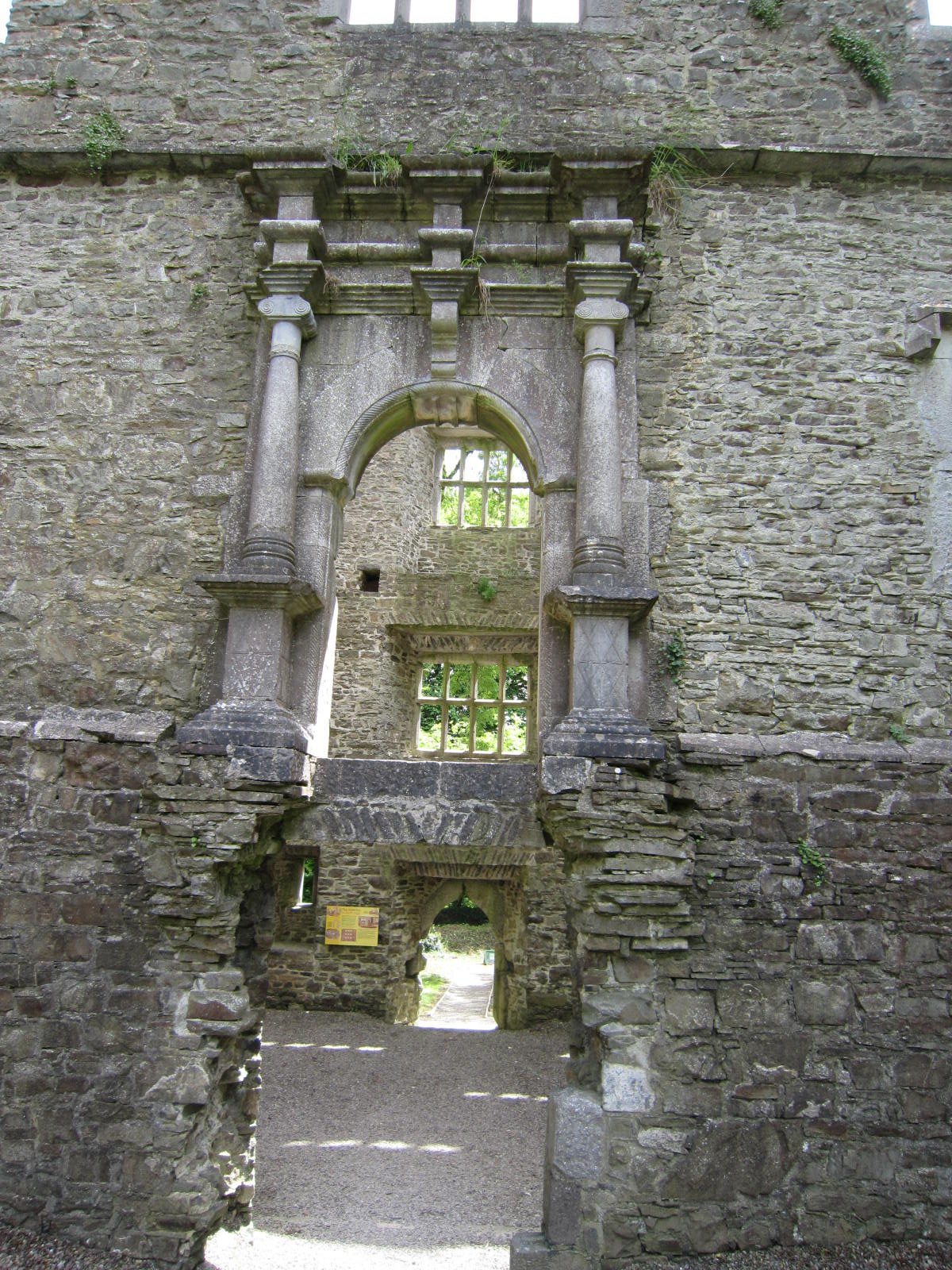 (For a very detailed account of the castle with far better photos than mine, please see The Irish Aesthete.)
(For a very detailed account of the castle with far better photos than mine, please see The Irish Aesthete.)
One legend about the castle is that all the stonemasons happened to be named John, and so originally the castle was known as Carrig-na-Shane-Saor (the Rock of John the Mason). Another story I came across was that during construction, MacCarthy needed free labor, so he and his men snagged travelers passing by, put them to work as slaves, and would not release them until they had worked on the castle for a year.
Why the castle was never completed remains something of a mystery. Some accounts claim that English settlers were concerned that the size and fortification of the castle signaled more rebellion from the Irish, and the Privy Council of England halted construction. MacCarthy was so incensed, he had the blue tiles on the castle roof torn away and thrown into a stream. Other accounts hold that MacCarthy simply ran out of money to continue.
When MacCarthy’s son, Dermot Oge, succeeded him, Kanturk and the lands around it were heavily mortgaged. Dermot and his own son were killed during a Cromwellian battle in 1652, and at the end of the confederate war Kanturk Manor was awarded to Sir Phillip Perceval, an English Protestant. Sir Phillip’s descendant, Sir John Perceval, was a successful parliamentarian, named Baron of Burton, County Cork, in 1715, Viscount Perceval of Kanturk in 1722, and Earl of Egmont in 1733.
And this brings me to a very personal connection to the story.
In 1932, Kanturk was donated to the National Trust by Lucy, Countess of Egmont, the widow of the 7th Earl of Egmont who was killed in a car crash in England. Her conditions were that the castle be kept as a ruin, as it was at time of hand-over. It is designated as a national monument.
When I visited, I saw a lovely, well-kept place where the locals walk their dogs, just as I often walk my dogs along a beautiful street with a beautiful name: Countess of Egmont—on an island more than 4,000 miles away.
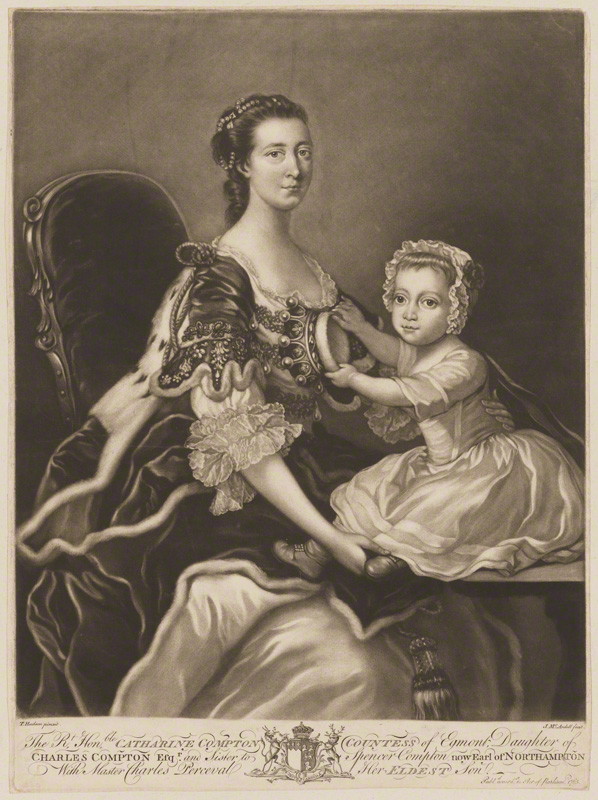
It turns out that Sir John Perceval, the 5th Baronet of Kanturk and the 2nd Earl of Egmont, obtained a king's grant for properties in northeast Florida during a brief period around the 1770s, when Spain ceded the lands to Britain in an exchange for lands elsewhere. Amelia Island was then called Egmont Island, where the Earl and Lady Egmont owned a large indigo plantation. The island was later renamed Amelia in honor of the daughter of King George II of England.
The portrait: Catherine Perceval (née Compton), Countess of Egmont; with Charles George Perceval, 2nd Baron Arden; by James Macardell, after Thomas Hudson, mezzotint, published 1765, NPG D2382
 An heiress, a castle, a fortune: what could go wrong?
An heiress, a castle, a fortune: what could go wrong?
The Prince of Glencurragh is available in ebook, soft cover and hard cover from online booksellers.
https://books2read.com/u/4N1Rj6
http://www.amazon.com/Prince-Glencurragh-Novel-Ireland-ebook/dp/B01GQPYQDY/
Nancy Blanton is the award-winning author of Sharavogue, a historical novel set in 17th Century Ireland during the time of Oliver Cromwell, and in the West Indies, island of Montserrat, on Irish-owned sugar plantations. She has two more historical novels underway, as well as a non-fiction book about personal branding, Brand Yourself Royally in 8 Simple Steps. She also wrote and illustrated a children's book, The Curious Adventure of Roodle Jones, and co-authored Heaven on the Half Shell, the Story of the Pacific Northwest's Love Affair with the Oyster.